ERP Implementation and Business Process Management
VerifiedAdded on 2020/03/01
|25
|5021
|90
AI Summary
This assignment delves into the complexities of implementing Enterprise Resource Planning (ERP) systems within organizations. It examines how ERP systems influence various business processes, emphasizing the importance of effective planning, execution, and user involvement. The analysis covers best practices for successful ERP implementation, highlighting potential challenges and strategies to overcome them. Furthermore, it explores the role of user participation in ensuring smooth system adoption and maximizing benefits.
Contribute Materials
Your contribution can guide someone’s learning journey. Share your
documents today.

Running head: IMPORTANCE OF ERP SYSTEMS IN BUSINESS
Importance of ERP systems in Business
Name of the Student:
Name of the University:
Author Note:
Importance of ERP systems in Business
Name of the Student:
Name of the University:
Author Note:
Secure Best Marks with AI Grader
Need help grading? Try our AI Grader for instant feedback on your assignments.
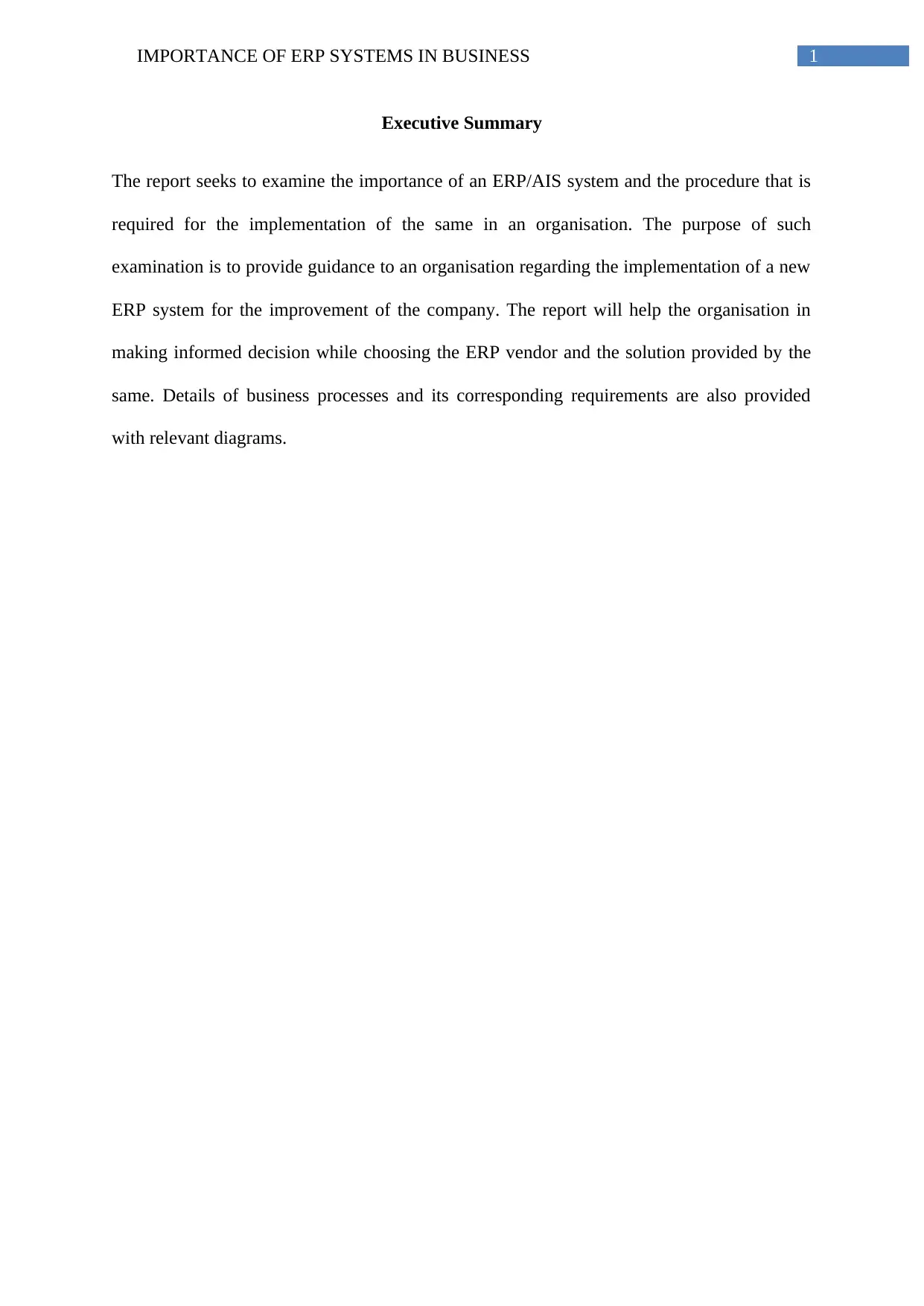
1IMPORTANCE OF ERP SYSTEMS IN BUSINESS
Executive Summary
The report seeks to examine the importance of an ERP/AIS system and the procedure that is
required for the implementation of the same in an organisation. The purpose of such
examination is to provide guidance to an organisation regarding the implementation of a new
ERP system for the improvement of the company. The report will help the organisation in
making informed decision while choosing the ERP vendor and the solution provided by the
same. Details of business processes and its corresponding requirements are also provided
with relevant diagrams.
Executive Summary
The report seeks to examine the importance of an ERP/AIS system and the procedure that is
required for the implementation of the same in an organisation. The purpose of such
examination is to provide guidance to an organisation regarding the implementation of a new
ERP system for the improvement of the company. The report will help the organisation in
making informed decision while choosing the ERP vendor and the solution provided by the
same. Details of business processes and its corresponding requirements are also provided
with relevant diagrams.
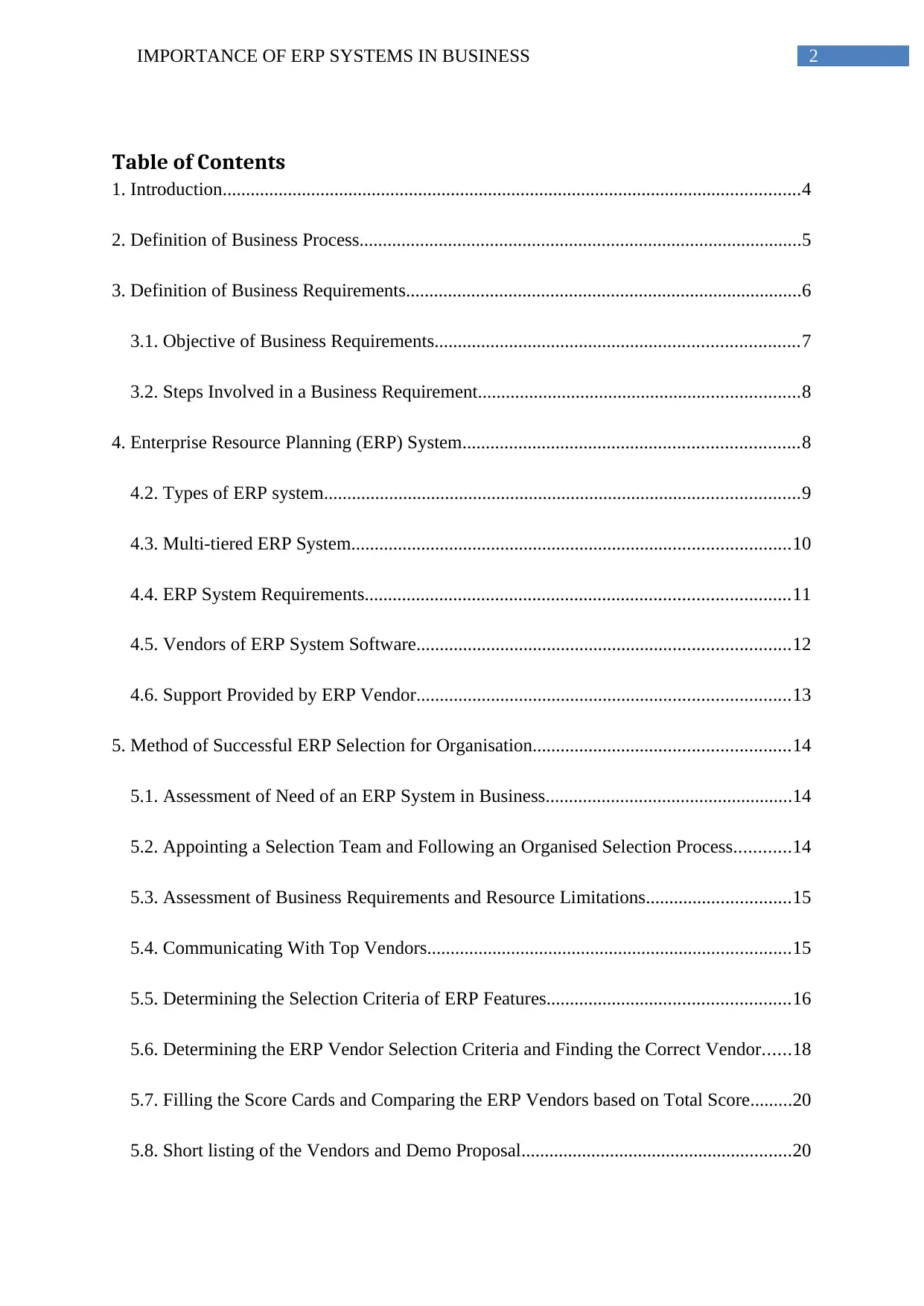
2IMPORTANCE OF ERP SYSTEMS IN BUSINESS
Table of Contents
1. Introduction............................................................................................................................4
2. Definition of Business Process...............................................................................................5
3. Definition of Business Requirements.....................................................................................6
3.1. Objective of Business Requirements..............................................................................7
3.2. Steps Involved in a Business Requirement.....................................................................8
4. Enterprise Resource Planning (ERP) System........................................................................8
4.2. Types of ERP system......................................................................................................9
4.3. Multi-tiered ERP System..............................................................................................10
4.4. ERP System Requirements...........................................................................................11
4.5. Vendors of ERP System Software................................................................................12
4.6. Support Provided by ERP Vendor................................................................................13
5. Method of Successful ERP Selection for Organisation.......................................................14
5.1. Assessment of Need of an ERP System in Business.....................................................14
5.2. Appointing a Selection Team and Following an Organised Selection Process............14
5.3. Assessment of Business Requirements and Resource Limitations...............................15
5.4. Communicating With Top Vendors..............................................................................15
5.5. Determining the Selection Criteria of ERP Features....................................................16
5.6. Determining the ERP Vendor Selection Criteria and Finding the Correct Vendor......18
5.7. Filling the Score Cards and Comparing the ERP Vendors based on Total Score.........20
5.8. Short listing of the Vendors and Demo Proposal..........................................................20
Table of Contents
1. Introduction............................................................................................................................4
2. Definition of Business Process...............................................................................................5
3. Definition of Business Requirements.....................................................................................6
3.1. Objective of Business Requirements..............................................................................7
3.2. Steps Involved in a Business Requirement.....................................................................8
4. Enterprise Resource Planning (ERP) System........................................................................8
4.2. Types of ERP system......................................................................................................9
4.3. Multi-tiered ERP System..............................................................................................10
4.4. ERP System Requirements...........................................................................................11
4.5. Vendors of ERP System Software................................................................................12
4.6. Support Provided by ERP Vendor................................................................................13
5. Method of Successful ERP Selection for Organisation.......................................................14
5.1. Assessment of Need of an ERP System in Business.....................................................14
5.2. Appointing a Selection Team and Following an Organised Selection Process............14
5.3. Assessment of Business Requirements and Resource Limitations...............................15
5.4. Communicating With Top Vendors..............................................................................15
5.5. Determining the Selection Criteria of ERP Features....................................................16
5.6. Determining the ERP Vendor Selection Criteria and Finding the Correct Vendor......18
5.7. Filling the Score Cards and Comparing the ERP Vendors based on Total Score.........20
5.8. Short listing of the Vendors and Demo Proposal..........................................................20
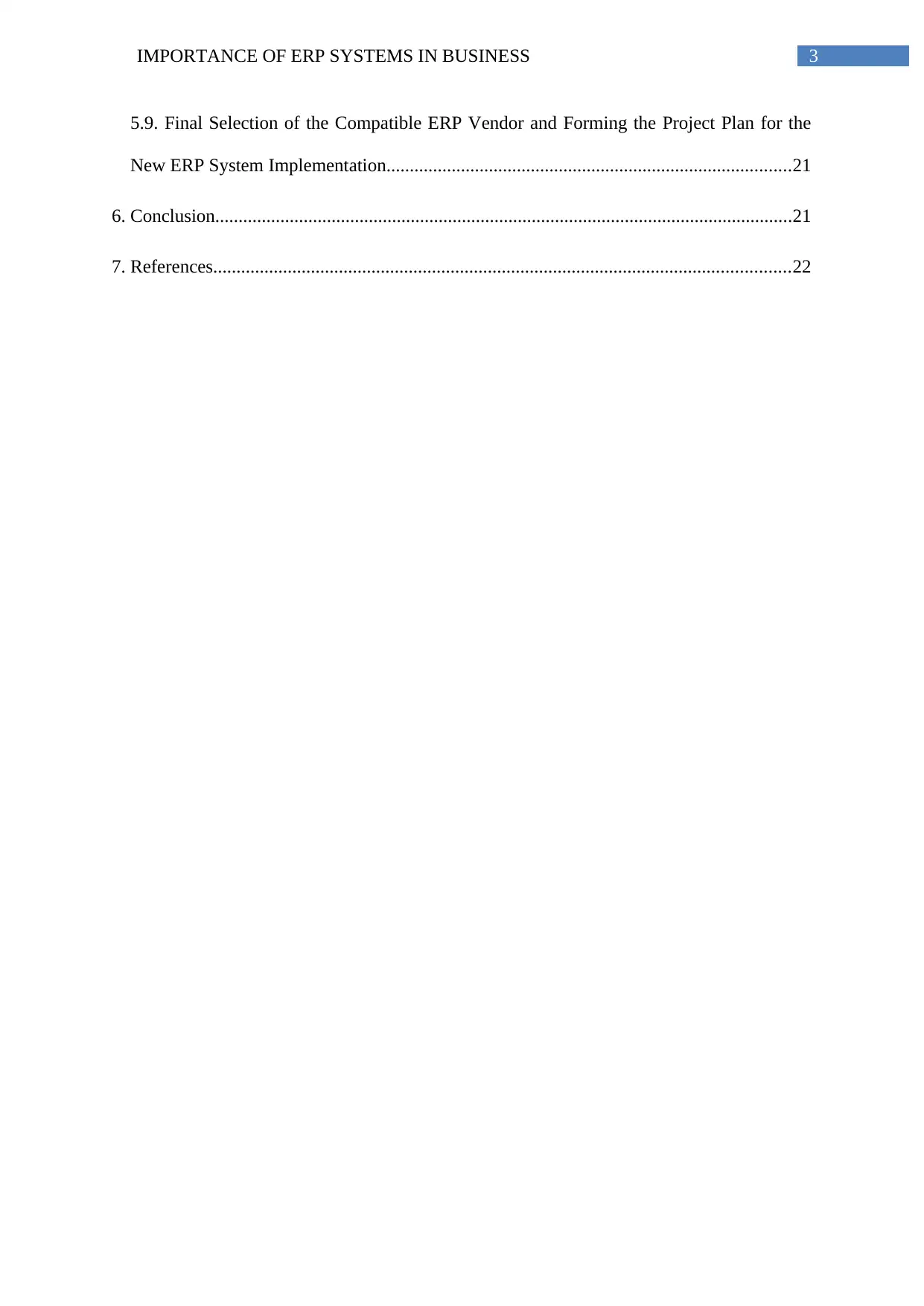
3IMPORTANCE OF ERP SYSTEMS IN BUSINESS
5.9. Final Selection of the Compatible ERP Vendor and Forming the Project Plan for the
New ERP System Implementation.......................................................................................21
6. Conclusion............................................................................................................................21
7. References............................................................................................................................22
5.9. Final Selection of the Compatible ERP Vendor and Forming the Project Plan for the
New ERP System Implementation.......................................................................................21
6. Conclusion............................................................................................................................21
7. References............................................................................................................................22
Secure Best Marks with AI Grader
Need help grading? Try our AI Grader for instant feedback on your assignments.
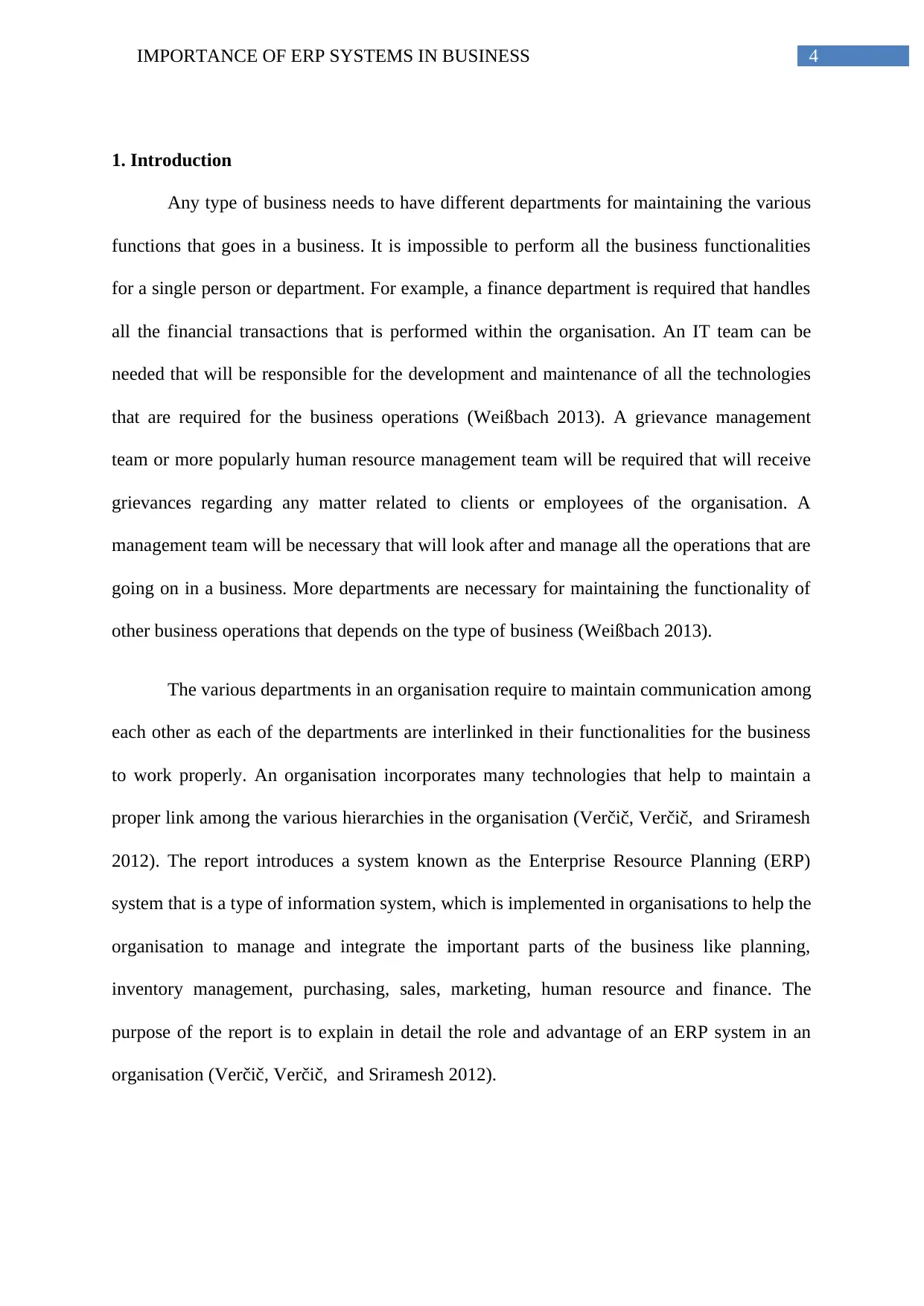
4IMPORTANCE OF ERP SYSTEMS IN BUSINESS
1. Introduction
Any type of business needs to have different departments for maintaining the various
functions that goes in a business. It is impossible to perform all the business functionalities
for a single person or department. For example, a finance department is required that handles
all the financial transactions that is performed within the organisation. An IT team can be
needed that will be responsible for the development and maintenance of all the technologies
that are required for the business operations (Weißbach 2013). A grievance management
team or more popularly human resource management team will be required that will receive
grievances regarding any matter related to clients or employees of the organisation. A
management team will be necessary that will look after and manage all the operations that are
going on in a business. More departments are necessary for maintaining the functionality of
other business operations that depends on the type of business (Weißbach 2013).
The various departments in an organisation require to maintain communication among
each other as each of the departments are interlinked in their functionalities for the business
to work properly. An organisation incorporates many technologies that help to maintain a
proper link among the various hierarchies in the organisation (Verčič, Verčič, and Sriramesh
2012). The report introduces a system known as the Enterprise Resource Planning (ERP)
system that is a type of information system, which is implemented in organisations to help the
organisation to manage and integrate the important parts of the business like planning,
inventory management, purchasing, sales, marketing, human resource and finance. The
purpose of the report is to explain in detail the role and advantage of an ERP system in an
organisation (Verčič, Verčič, and Sriramesh 2012).
1. Introduction
Any type of business needs to have different departments for maintaining the various
functions that goes in a business. It is impossible to perform all the business functionalities
for a single person or department. For example, a finance department is required that handles
all the financial transactions that is performed within the organisation. An IT team can be
needed that will be responsible for the development and maintenance of all the technologies
that are required for the business operations (Weißbach 2013). A grievance management
team or more popularly human resource management team will be required that will receive
grievances regarding any matter related to clients or employees of the organisation. A
management team will be necessary that will look after and manage all the operations that are
going on in a business. More departments are necessary for maintaining the functionality of
other business operations that depends on the type of business (Weißbach 2013).
The various departments in an organisation require to maintain communication among
each other as each of the departments are interlinked in their functionalities for the business
to work properly. An organisation incorporates many technologies that help to maintain a
proper link among the various hierarchies in the organisation (Verčič, Verčič, and Sriramesh
2012). The report introduces a system known as the Enterprise Resource Planning (ERP)
system that is a type of information system, which is implemented in organisations to help the
organisation to manage and integrate the important parts of the business like planning,
inventory management, purchasing, sales, marketing, human resource and finance. The
purpose of the report is to explain in detail the role and advantage of an ERP system in an
organisation (Verčič, Verčič, and Sriramesh 2012).
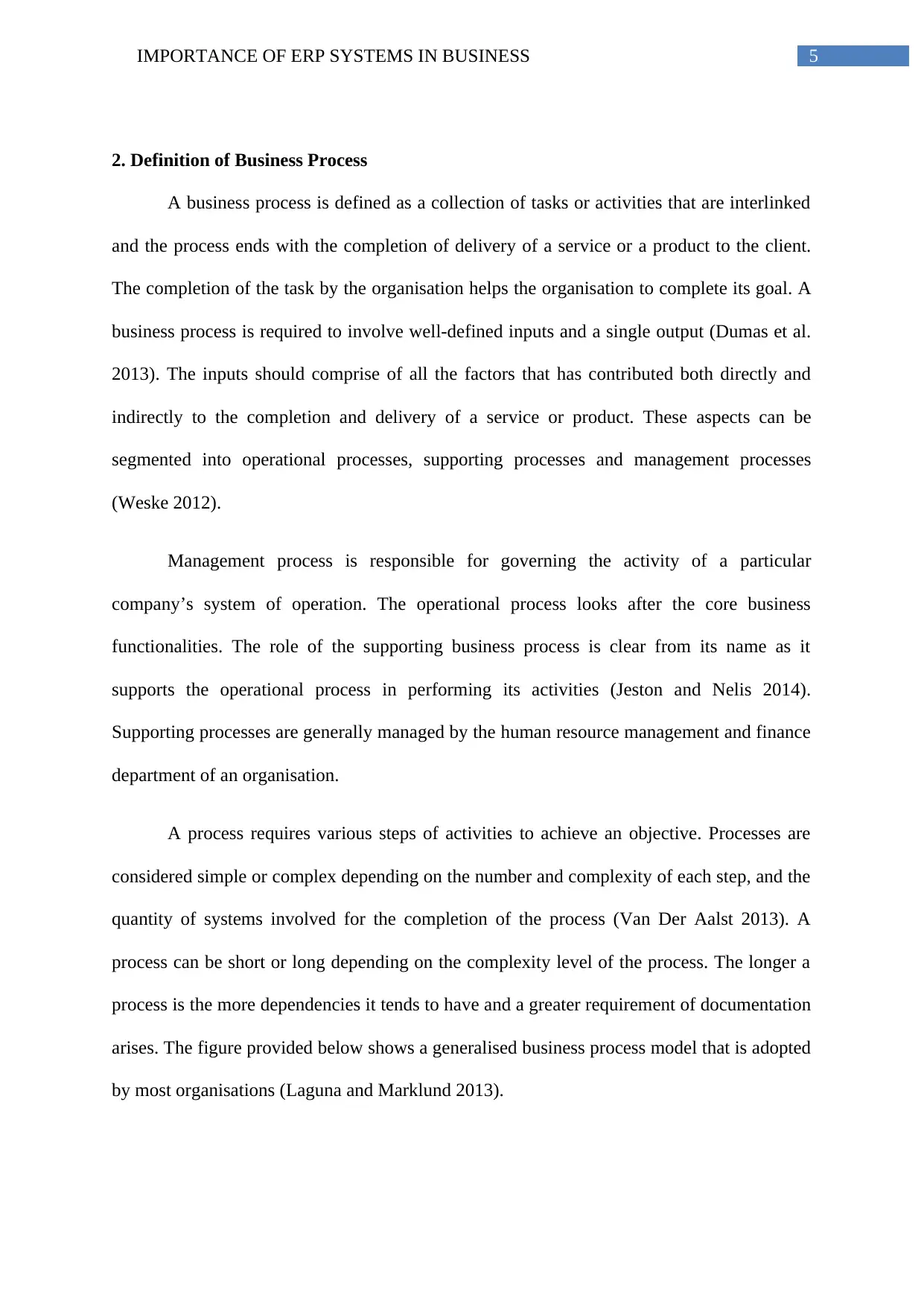
5IMPORTANCE OF ERP SYSTEMS IN BUSINESS
2. Definition of Business Process
A business process is defined as a collection of tasks or activities that are interlinked
and the process ends with the completion of delivery of a service or a product to the client.
The completion of the task by the organisation helps the organisation to complete its goal. A
business process is required to involve well-defined inputs and a single output (Dumas et al.
2013). The inputs should comprise of all the factors that has contributed both directly and
indirectly to the completion and delivery of a service or product. These aspects can be
segmented into operational processes, supporting processes and management processes
(Weske 2012).
Management process is responsible for governing the activity of a particular
company’s system of operation. The operational process looks after the core business
functionalities. The role of the supporting business process is clear from its name as it
supports the operational process in performing its activities (Jeston and Nelis 2014).
Supporting processes are generally managed by the human resource management and finance
department of an organisation.
A process requires various steps of activities to achieve an objective. Processes are
considered simple or complex depending on the number and complexity of each step, and the
quantity of systems involved for the completion of the process (Van Der Aalst 2013). A
process can be short or long depending on the complexity level of the process. The longer a
process is the more dependencies it tends to have and a greater requirement of documentation
arises. The figure provided below shows a generalised business process model that is adopted
by most organisations (Laguna and Marklund 2013).
2. Definition of Business Process
A business process is defined as a collection of tasks or activities that are interlinked
and the process ends with the completion of delivery of a service or a product to the client.
The completion of the task by the organisation helps the organisation to complete its goal. A
business process is required to involve well-defined inputs and a single output (Dumas et al.
2013). The inputs should comprise of all the factors that has contributed both directly and
indirectly to the completion and delivery of a service or product. These aspects can be
segmented into operational processes, supporting processes and management processes
(Weske 2012).
Management process is responsible for governing the activity of a particular
company’s system of operation. The operational process looks after the core business
functionalities. The role of the supporting business process is clear from its name as it
supports the operational process in performing its activities (Jeston and Nelis 2014).
Supporting processes are generally managed by the human resource management and finance
department of an organisation.
A process requires various steps of activities to achieve an objective. Processes are
considered simple or complex depending on the number and complexity of each step, and the
quantity of systems involved for the completion of the process (Van Der Aalst 2013). A
process can be short or long depending on the complexity level of the process. The longer a
process is the more dependencies it tends to have and a greater requirement of documentation
arises. The figure provided below shows a generalised business process model that is adopted
by most organisations (Laguna and Marklund 2013).
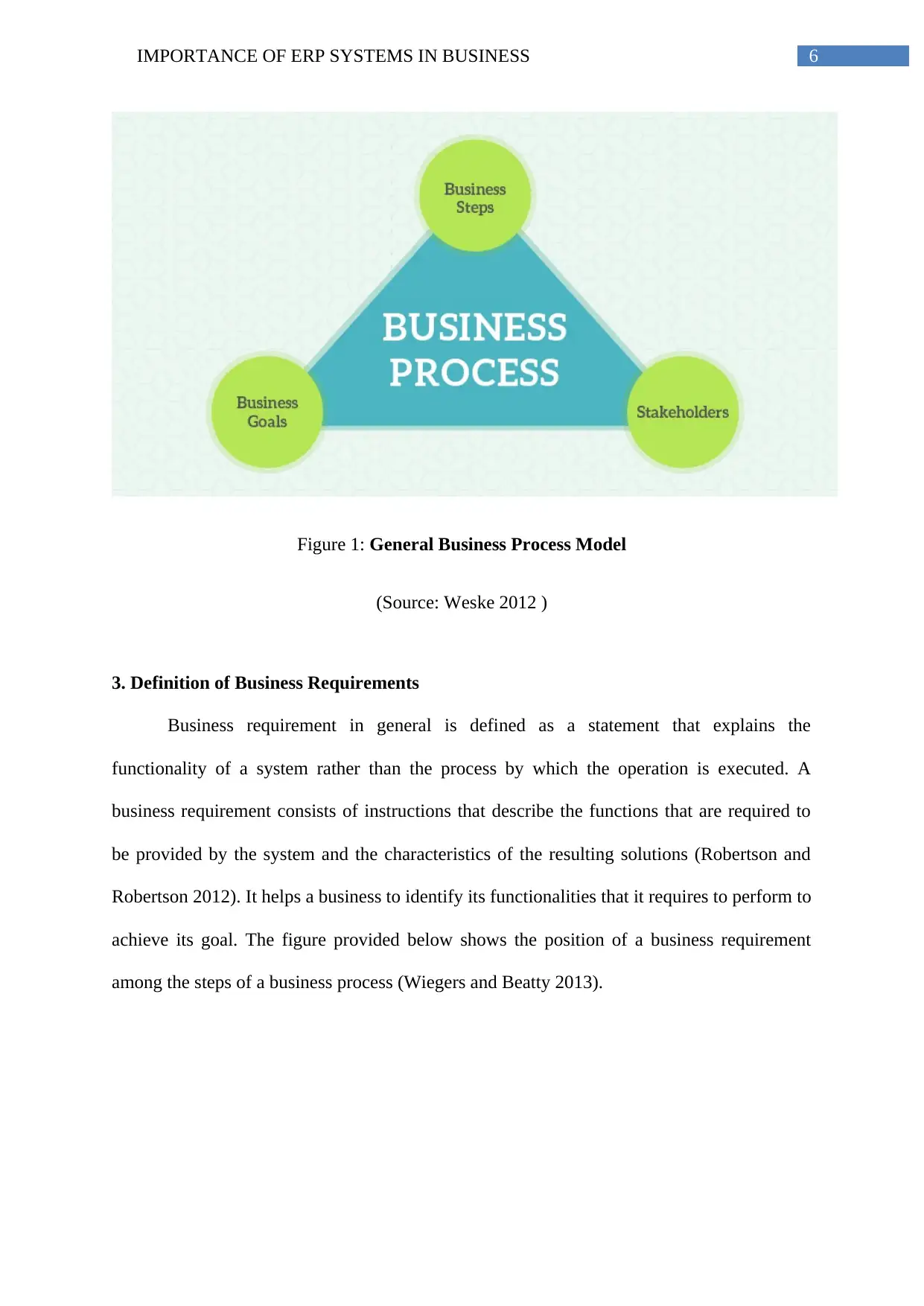
6IMPORTANCE OF ERP SYSTEMS IN BUSINESS
Figure 1: General Business Process Model
(Source: Weske 2012 )
3. Definition of Business Requirements
Business requirement in general is defined as a statement that explains the
functionality of a system rather than the process by which the operation is executed. A
business requirement consists of instructions that describe the functions that are required to
be provided by the system and the characteristics of the resulting solutions (Robertson and
Robertson 2012). It helps a business to identify its functionalities that it requires to perform to
achieve its goal. The figure provided below shows the position of a business requirement
among the steps of a business process (Wiegers and Beatty 2013).
Figure 1: General Business Process Model
(Source: Weske 2012 )
3. Definition of Business Requirements
Business requirement in general is defined as a statement that explains the
functionality of a system rather than the process by which the operation is executed. A
business requirement consists of instructions that describe the functions that are required to
be provided by the system and the characteristics of the resulting solutions (Robertson and
Robertson 2012). It helps a business to identify its functionalities that it requires to perform to
achieve its goal. The figure provided below shows the position of a business requirement
among the steps of a business process (Wiegers and Beatty 2013).
Paraphrase This Document
Need a fresh take? Get an instant paraphrase of this document with our AI Paraphraser
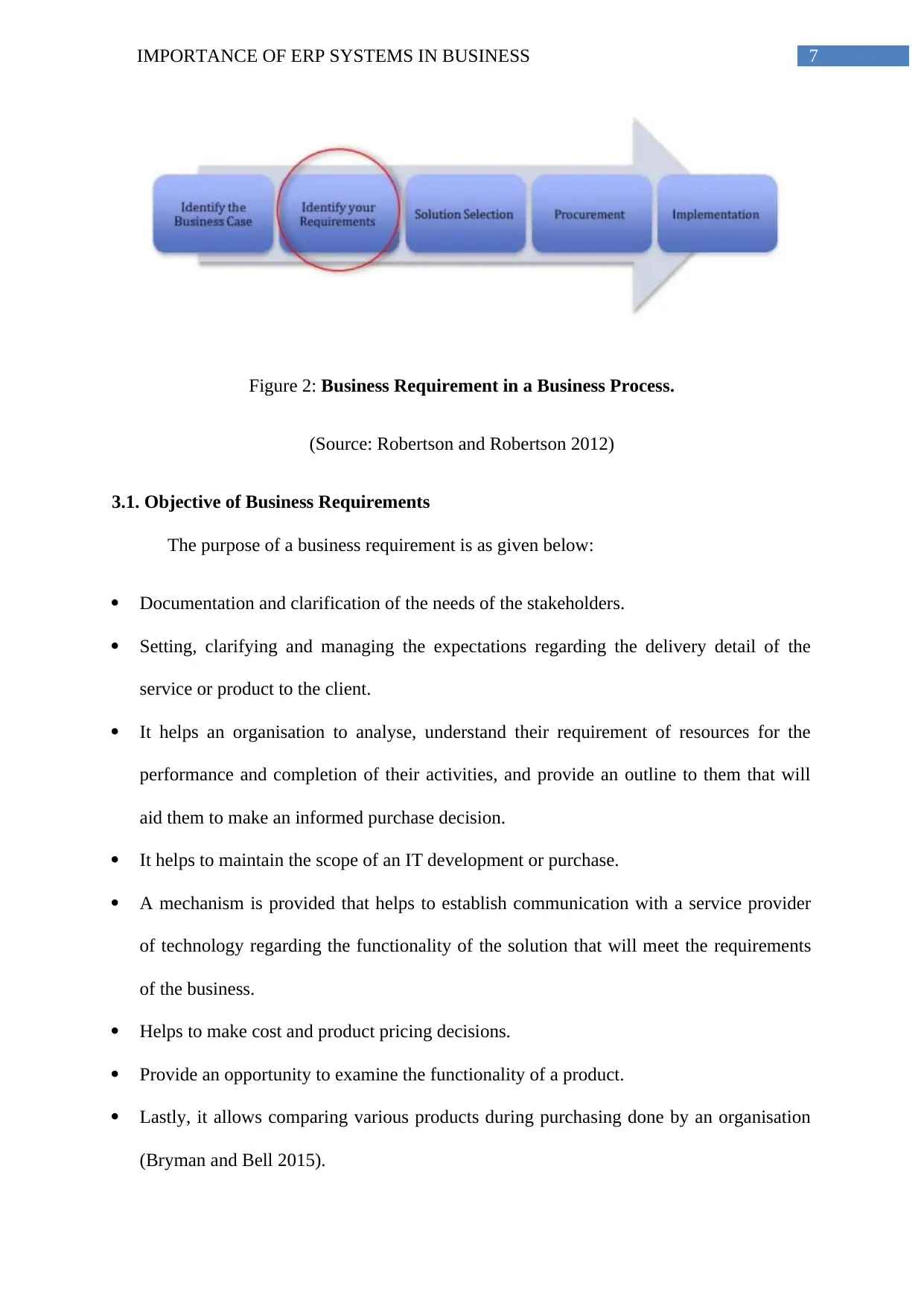
7IMPORTANCE OF ERP SYSTEMS IN BUSINESS
Figure 2: Business Requirement in a Business Process.
(Source: Robertson and Robertson 2012)
3.1. Objective of Business Requirements
The purpose of a business requirement is as given below:
Documentation and clarification of the needs of the stakeholders.
Setting, clarifying and managing the expectations regarding the delivery detail of the
service or product to the client.
It helps an organisation to analyse, understand their requirement of resources for the
performance and completion of their activities, and provide an outline to them that will
aid them to make an informed purchase decision.
It helps to maintain the scope of an IT development or purchase.
A mechanism is provided that helps to establish communication with a service provider
of technology regarding the functionality of the solution that will meet the requirements
of the business.
Helps to make cost and product pricing decisions.
Provide an opportunity to examine the functionality of a product.
Lastly, it allows comparing various products during purchasing done by an organisation
(Bryman and Bell 2015).
Figure 2: Business Requirement in a Business Process.
(Source: Robertson and Robertson 2012)
3.1. Objective of Business Requirements
The purpose of a business requirement is as given below:
Documentation and clarification of the needs of the stakeholders.
Setting, clarifying and managing the expectations regarding the delivery detail of the
service or product to the client.
It helps an organisation to analyse, understand their requirement of resources for the
performance and completion of their activities, and provide an outline to them that will
aid them to make an informed purchase decision.
It helps to maintain the scope of an IT development or purchase.
A mechanism is provided that helps to establish communication with a service provider
of technology regarding the functionality of the solution that will meet the requirements
of the business.
Helps to make cost and product pricing decisions.
Provide an opportunity to examine the functionality of a product.
Lastly, it allows comparing various products during purchasing done by an organisation
(Bryman and Bell 2015).
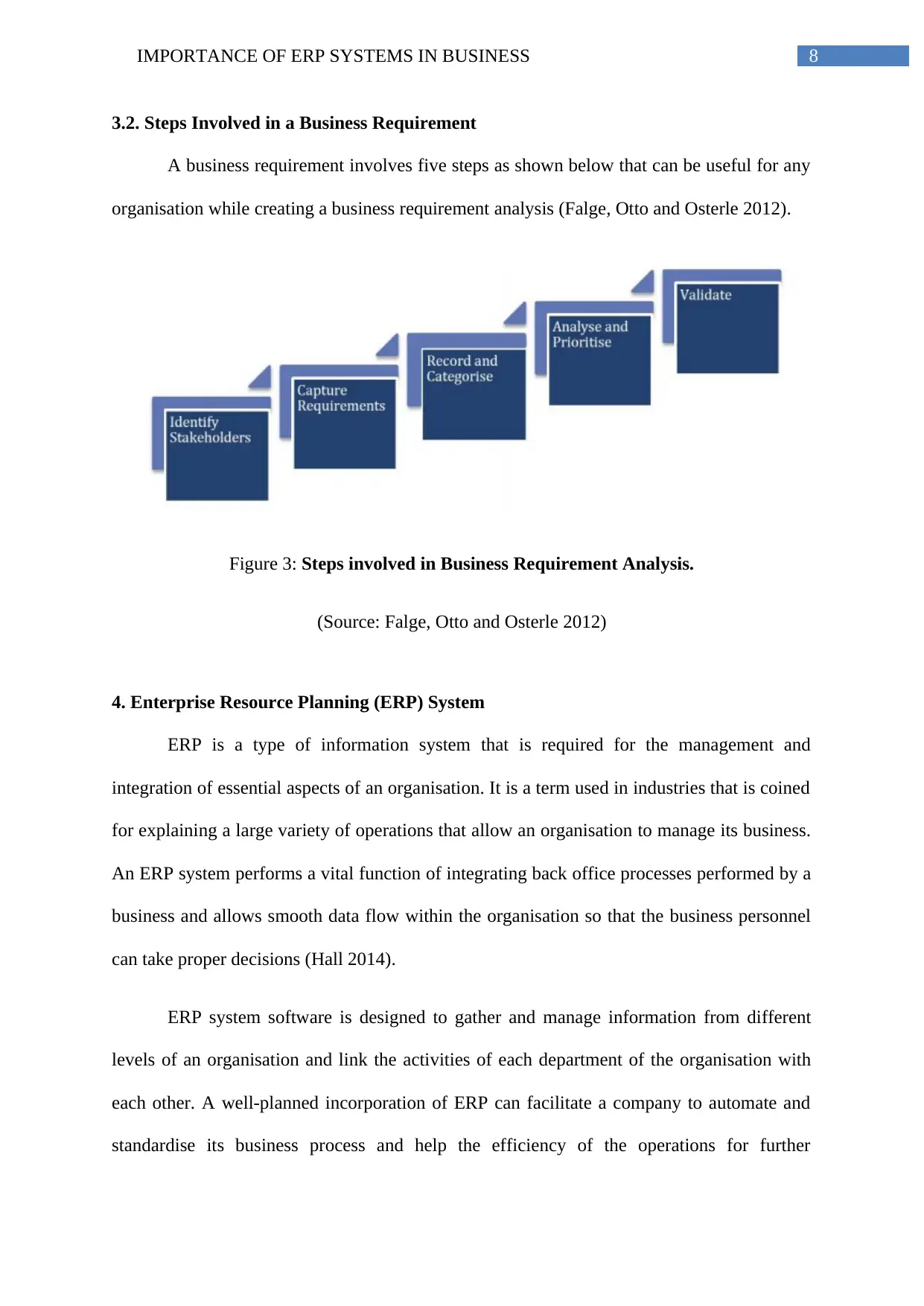
8IMPORTANCE OF ERP SYSTEMS IN BUSINESS
3.2. Steps Involved in a Business Requirement
A business requirement involves five steps as shown below that can be useful for any
organisation while creating a business requirement analysis (Falge, Otto and Osterle 2012).
Figure 3: Steps involved in Business Requirement Analysis.
(Source: Falge, Otto and Osterle 2012)
4. Enterprise Resource Planning (ERP) System
ERP is a type of information system that is required for the management and
integration of essential aspects of an organisation. It is a term used in industries that is coined
for explaining a large variety of operations that allow an organisation to manage its business.
An ERP system performs a vital function of integrating back office processes performed by a
business and allows smooth data flow within the organisation so that the business personnel
can take proper decisions (Hall 2014).
ERP system software is designed to gather and manage information from different
levels of an organisation and link the activities of each department of the organisation with
each other. A well-planned incorporation of ERP can facilitate a company to automate and
standardise its business process and help the efficiency of the operations for further
3.2. Steps Involved in a Business Requirement
A business requirement involves five steps as shown below that can be useful for any
organisation while creating a business requirement analysis (Falge, Otto and Osterle 2012).
Figure 3: Steps involved in Business Requirement Analysis.
(Source: Falge, Otto and Osterle 2012)
4. Enterprise Resource Planning (ERP) System
ERP is a type of information system that is required for the management and
integration of essential aspects of an organisation. It is a term used in industries that is coined
for explaining a large variety of operations that allow an organisation to manage its business.
An ERP system performs a vital function of integrating back office processes performed by a
business and allows smooth data flow within the organisation so that the business personnel
can take proper decisions (Hall 2014).
ERP system software is designed to gather and manage information from different
levels of an organisation and link the activities of each department of the organisation with
each other. A well-planned incorporation of ERP can facilitate a company to automate and
standardise its business process and help the efficiency of the operations for further
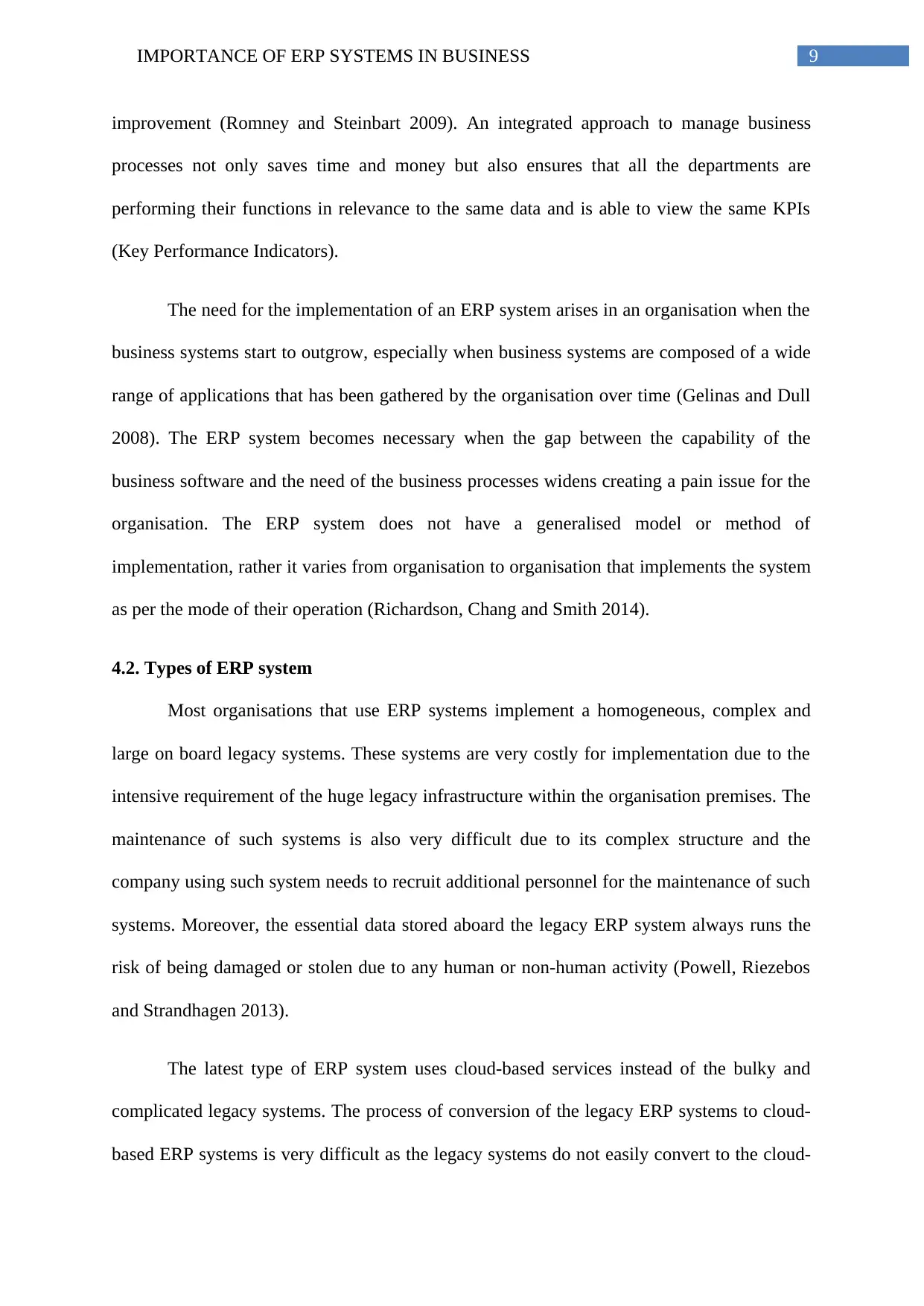
9IMPORTANCE OF ERP SYSTEMS IN BUSINESS
improvement (Romney and Steinbart 2009). An integrated approach to manage business
processes not only saves time and money but also ensures that all the departments are
performing their functions in relevance to the same data and is able to view the same KPIs
(Key Performance Indicators).
The need for the implementation of an ERP system arises in an organisation when the
business systems start to outgrow, especially when business systems are composed of a wide
range of applications that has been gathered by the organisation over time (Gelinas and Dull
2008). The ERP system becomes necessary when the gap between the capability of the
business software and the need of the business processes widens creating a pain issue for the
organisation. The ERP system does not have a generalised model or method of
implementation, rather it varies from organisation to organisation that implements the system
as per the mode of their operation (Richardson, Chang and Smith 2014).
4.2. Types of ERP system
Most organisations that use ERP systems implement a homogeneous, complex and
large on board legacy systems. These systems are very costly for implementation due to the
intensive requirement of the huge legacy infrastructure within the organisation premises. The
maintenance of such systems is also very difficult due to its complex structure and the
company using such system needs to recruit additional personnel for the maintenance of such
systems. Moreover, the essential data stored aboard the legacy ERP system always runs the
risk of being damaged or stolen due to any human or non-human activity (Powell, Riezebos
and Strandhagen 2013).
The latest type of ERP system uses cloud-based services instead of the bulky and
complicated legacy systems. The process of conversion of the legacy ERP systems to cloud-
based ERP systems is very difficult as the legacy systems do not easily convert to the cloud-
improvement (Romney and Steinbart 2009). An integrated approach to manage business
processes not only saves time and money but also ensures that all the departments are
performing their functions in relevance to the same data and is able to view the same KPIs
(Key Performance Indicators).
The need for the implementation of an ERP system arises in an organisation when the
business systems start to outgrow, especially when business systems are composed of a wide
range of applications that has been gathered by the organisation over time (Gelinas and Dull
2008). The ERP system becomes necessary when the gap between the capability of the
business software and the need of the business processes widens creating a pain issue for the
organisation. The ERP system does not have a generalised model or method of
implementation, rather it varies from organisation to organisation that implements the system
as per the mode of their operation (Richardson, Chang and Smith 2014).
4.2. Types of ERP system
Most organisations that use ERP systems implement a homogeneous, complex and
large on board legacy systems. These systems are very costly for implementation due to the
intensive requirement of the huge legacy infrastructure within the organisation premises. The
maintenance of such systems is also very difficult due to its complex structure and the
company using such system needs to recruit additional personnel for the maintenance of such
systems. Moreover, the essential data stored aboard the legacy ERP system always runs the
risk of being damaged or stolen due to any human or non-human activity (Powell, Riezebos
and Strandhagen 2013).
The latest type of ERP system uses cloud-based services instead of the bulky and
complicated legacy systems. The process of conversion of the legacy ERP systems to cloud-
based ERP systems is very difficult as the legacy systems do not easily convert to the cloud-
Secure Best Marks with AI Grader
Need help grading? Try our AI Grader for instant feedback on your assignments.
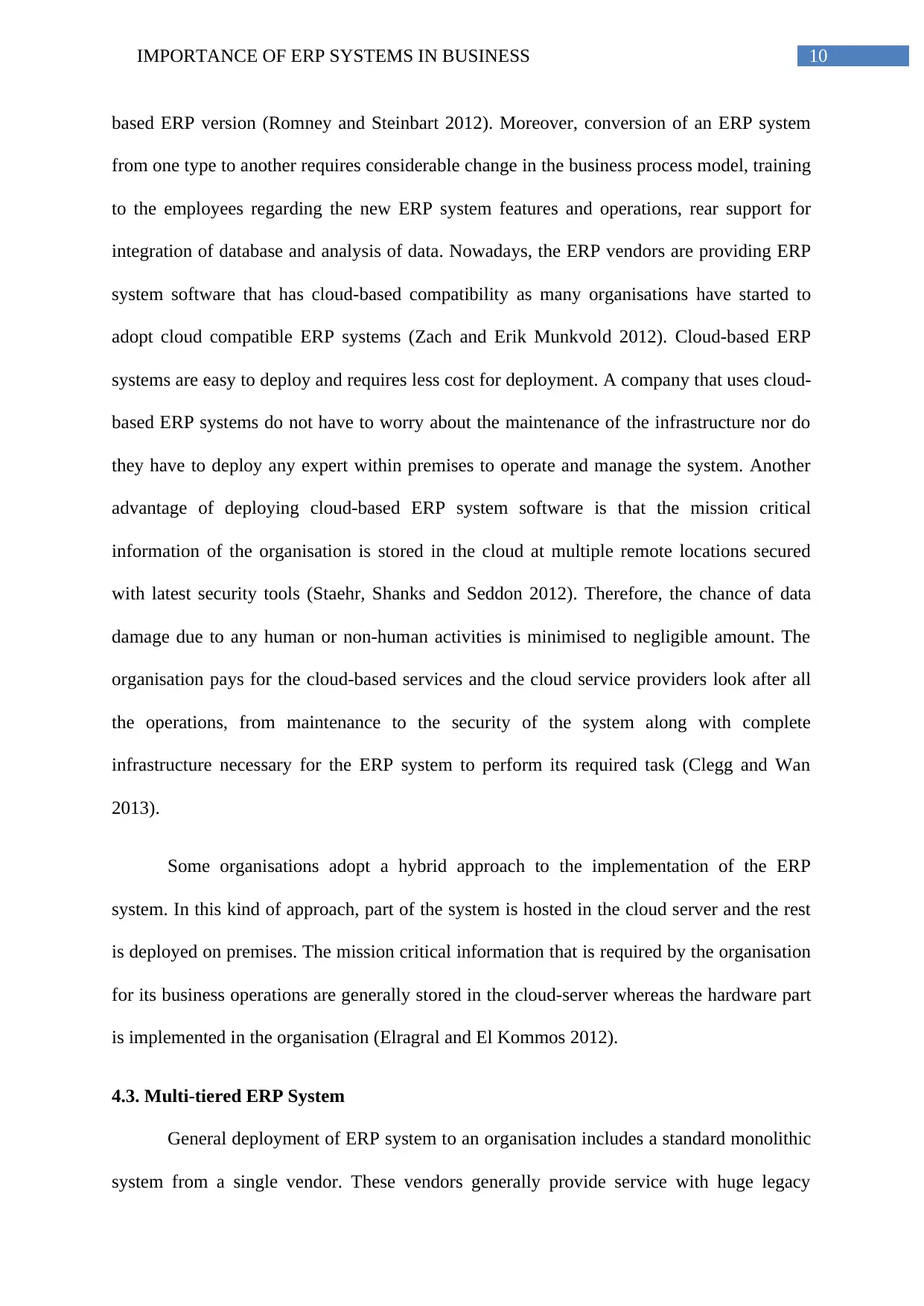
10IMPORTANCE OF ERP SYSTEMS IN BUSINESS
based ERP version (Romney and Steinbart 2012). Moreover, conversion of an ERP system
from one type to another requires considerable change in the business process model, training
to the employees regarding the new ERP system features and operations, rear support for
integration of database and analysis of data. Nowadays, the ERP vendors are providing ERP
system software that has cloud-based compatibility as many organisations have started to
adopt cloud compatible ERP systems (Zach and Erik Munkvold 2012). Cloud-based ERP
systems are easy to deploy and requires less cost for deployment. A company that uses cloud-
based ERP systems do not have to worry about the maintenance of the infrastructure nor do
they have to deploy any expert within premises to operate and manage the system. Another
advantage of deploying cloud-based ERP system software is that the mission critical
information of the organisation is stored in the cloud at multiple remote locations secured
with latest security tools (Staehr, Shanks and Seddon 2012). Therefore, the chance of data
damage due to any human or non-human activities is minimised to negligible amount. The
organisation pays for the cloud-based services and the cloud service providers look after all
the operations, from maintenance to the security of the system along with complete
infrastructure necessary for the ERP system to perform its required task (Clegg and Wan
2013).
Some organisations adopt a hybrid approach to the implementation of the ERP
system. In this kind of approach, part of the system is hosted in the cloud server and the rest
is deployed on premises. The mission critical information that is required by the organisation
for its business operations are generally stored in the cloud-server whereas the hardware part
is implemented in the organisation (Elragral and El Kommos 2012).
4.3. Multi-tiered ERP System
General deployment of ERP system to an organisation includes a standard monolithic
system from a single vendor. These vendors generally provide service with huge legacy
based ERP version (Romney and Steinbart 2012). Moreover, conversion of an ERP system
from one type to another requires considerable change in the business process model, training
to the employees regarding the new ERP system features and operations, rear support for
integration of database and analysis of data. Nowadays, the ERP vendors are providing ERP
system software that has cloud-based compatibility as many organisations have started to
adopt cloud compatible ERP systems (Zach and Erik Munkvold 2012). Cloud-based ERP
systems are easy to deploy and requires less cost for deployment. A company that uses cloud-
based ERP systems do not have to worry about the maintenance of the infrastructure nor do
they have to deploy any expert within premises to operate and manage the system. Another
advantage of deploying cloud-based ERP system software is that the mission critical
information of the organisation is stored in the cloud at multiple remote locations secured
with latest security tools (Staehr, Shanks and Seddon 2012). Therefore, the chance of data
damage due to any human or non-human activities is minimised to negligible amount. The
organisation pays for the cloud-based services and the cloud service providers look after all
the operations, from maintenance to the security of the system along with complete
infrastructure necessary for the ERP system to perform its required task (Clegg and Wan
2013).
Some organisations adopt a hybrid approach to the implementation of the ERP
system. In this kind of approach, part of the system is hosted in the cloud server and the rest
is deployed on premises. The mission critical information that is required by the organisation
for its business operations are generally stored in the cloud-server whereas the hardware part
is implemented in the organisation (Elragral and El Kommos 2012).
4.3. Multi-tiered ERP System
General deployment of ERP system to an organisation includes a standard monolithic
system from a single vendor. These vendors generally provide service with huge legacy
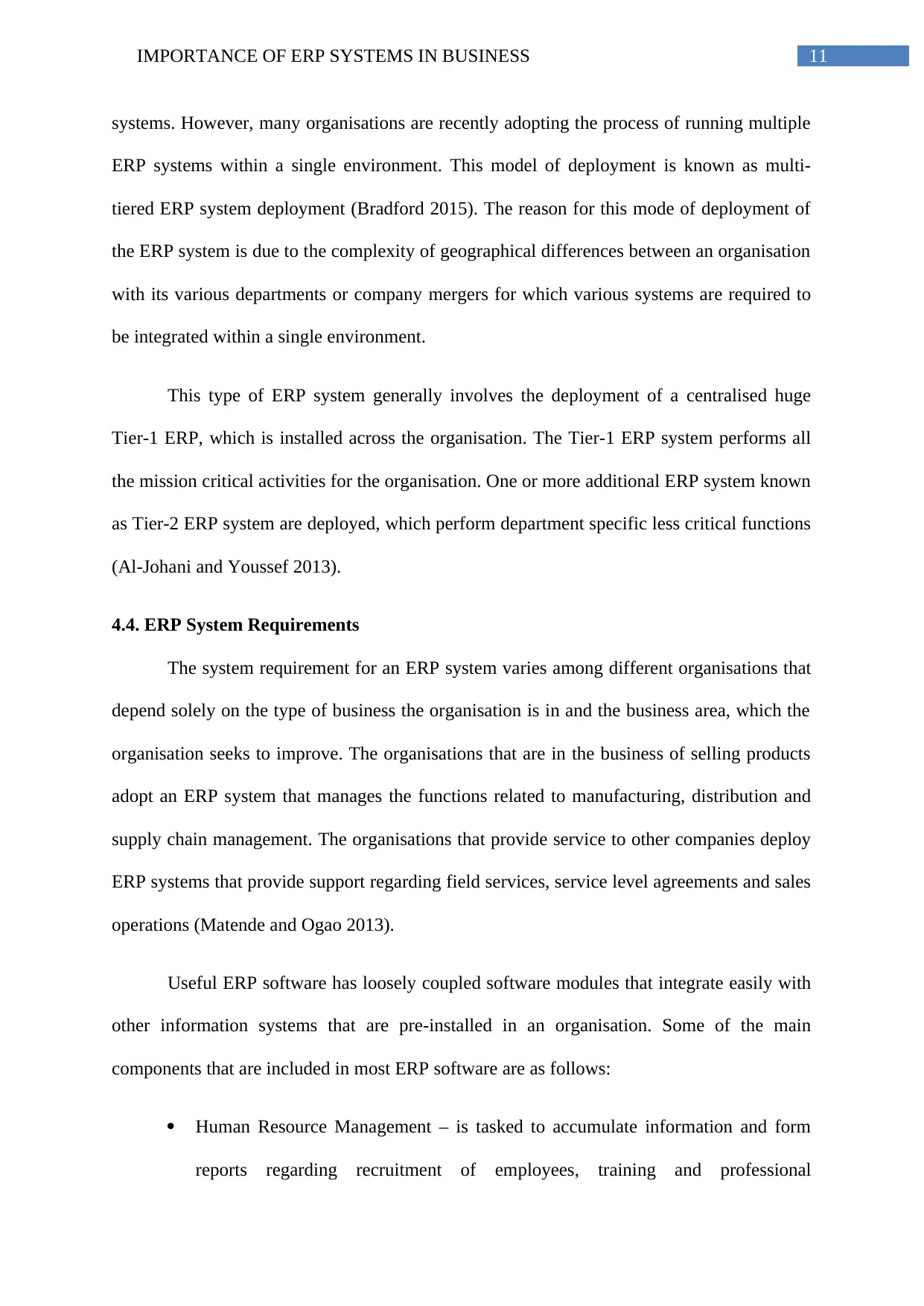
11IMPORTANCE OF ERP SYSTEMS IN BUSINESS
systems. However, many organisations are recently adopting the process of running multiple
ERP systems within a single environment. This model of deployment is known as multi-
tiered ERP system deployment (Bradford 2015). The reason for this mode of deployment of
the ERP system is due to the complexity of geographical differences between an organisation
with its various departments or company mergers for which various systems are required to
be integrated within a single environment.
This type of ERP system generally involves the deployment of a centralised huge
Tier-1 ERP, which is installed across the organisation. The Tier-1 ERP system performs all
the mission critical activities for the organisation. One or more additional ERP system known
as Tier-2 ERP system are deployed, which perform department specific less critical functions
(Al-Johani and Youssef 2013).
4.4. ERP System Requirements
The system requirement for an ERP system varies among different organisations that
depend solely on the type of business the organisation is in and the business area, which the
organisation seeks to improve. The organisations that are in the business of selling products
adopt an ERP system that manages the functions related to manufacturing, distribution and
supply chain management. The organisations that provide service to other companies deploy
ERP systems that provide support regarding field services, service level agreements and sales
operations (Matende and Ogao 2013).
Useful ERP software has loosely coupled software modules that integrate easily with
other information systems that are pre-installed in an organisation. Some of the main
components that are included in most ERP software are as follows:
Human Resource Management – is tasked to accumulate information and form
reports regarding recruitment of employees, training and professional
systems. However, many organisations are recently adopting the process of running multiple
ERP systems within a single environment. This model of deployment is known as multi-
tiered ERP system deployment (Bradford 2015). The reason for this mode of deployment of
the ERP system is due to the complexity of geographical differences between an organisation
with its various departments or company mergers for which various systems are required to
be integrated within a single environment.
This type of ERP system generally involves the deployment of a centralised huge
Tier-1 ERP, which is installed across the organisation. The Tier-1 ERP system performs all
the mission critical activities for the organisation. One or more additional ERP system known
as Tier-2 ERP system are deployed, which perform department specific less critical functions
(Al-Johani and Youssef 2013).
4.4. ERP System Requirements
The system requirement for an ERP system varies among different organisations that
depend solely on the type of business the organisation is in and the business area, which the
organisation seeks to improve. The organisations that are in the business of selling products
adopt an ERP system that manages the functions related to manufacturing, distribution and
supply chain management. The organisations that provide service to other companies deploy
ERP systems that provide support regarding field services, service level agreements and sales
operations (Matende and Ogao 2013).
Useful ERP software has loosely coupled software modules that integrate easily with
other information systems that are pre-installed in an organisation. Some of the main
components that are included in most ERP software are as follows:
Human Resource Management – is tasked to accumulate information and form
reports regarding recruitment of employees, training and professional
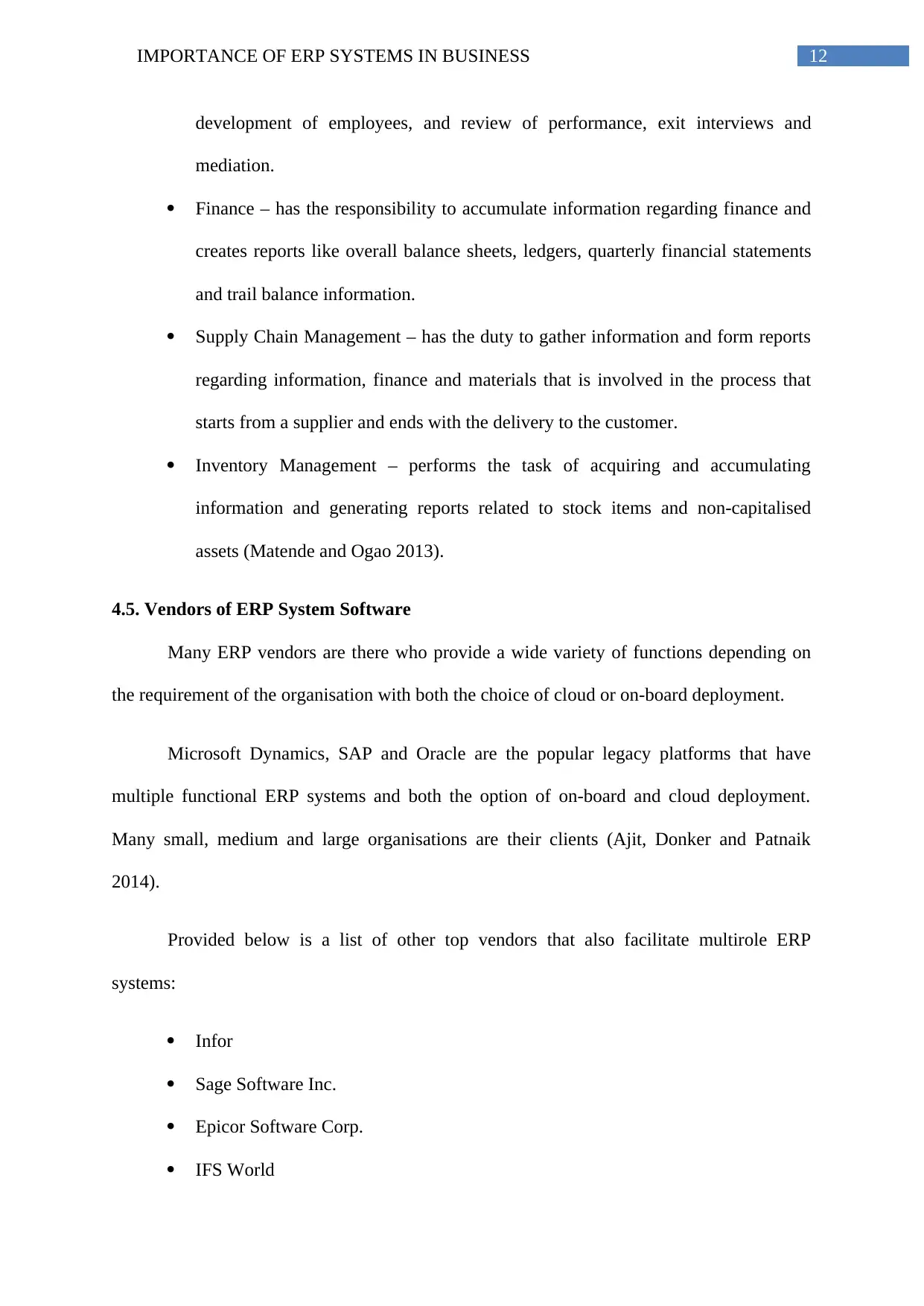
12IMPORTANCE OF ERP SYSTEMS IN BUSINESS
development of employees, and review of performance, exit interviews and
mediation.
Finance – has the responsibility to accumulate information regarding finance and
creates reports like overall balance sheets, ledgers, quarterly financial statements
and trail balance information.
Supply Chain Management – has the duty to gather information and form reports
regarding information, finance and materials that is involved in the process that
starts from a supplier and ends with the delivery to the customer.
Inventory Management – performs the task of acquiring and accumulating
information and generating reports related to stock items and non-capitalised
assets (Matende and Ogao 2013).
4.5. Vendors of ERP System Software
Many ERP vendors are there who provide a wide variety of functions depending on
the requirement of the organisation with both the choice of cloud or on-board deployment.
Microsoft Dynamics, SAP and Oracle are the popular legacy platforms that have
multiple functional ERP systems and both the option of on-board and cloud deployment.
Many small, medium and large organisations are their clients (Ajit, Donker and Patnaik
2014).
Provided below is a list of other top vendors that also facilitate multirole ERP
systems:
Infor
Sage Software Inc.
Epicor Software Corp.
IFS World
development of employees, and review of performance, exit interviews and
mediation.
Finance – has the responsibility to accumulate information regarding finance and
creates reports like overall balance sheets, ledgers, quarterly financial statements
and trail balance information.
Supply Chain Management – has the duty to gather information and form reports
regarding information, finance and materials that is involved in the process that
starts from a supplier and ends with the delivery to the customer.
Inventory Management – performs the task of acquiring and accumulating
information and generating reports related to stock items and non-capitalised
assets (Matende and Ogao 2013).
4.5. Vendors of ERP System Software
Many ERP vendors are there who provide a wide variety of functions depending on
the requirement of the organisation with both the choice of cloud or on-board deployment.
Microsoft Dynamics, SAP and Oracle are the popular legacy platforms that have
multiple functional ERP systems and both the option of on-board and cloud deployment.
Many small, medium and large organisations are their clients (Ajit, Donker and Patnaik
2014).
Provided below is a list of other top vendors that also facilitate multirole ERP
systems:
Infor
Sage Software Inc.
Epicor Software Corp.
IFS World
Paraphrase This Document
Need a fresh take? Get an instant paraphrase of this document with our AI Paraphraser
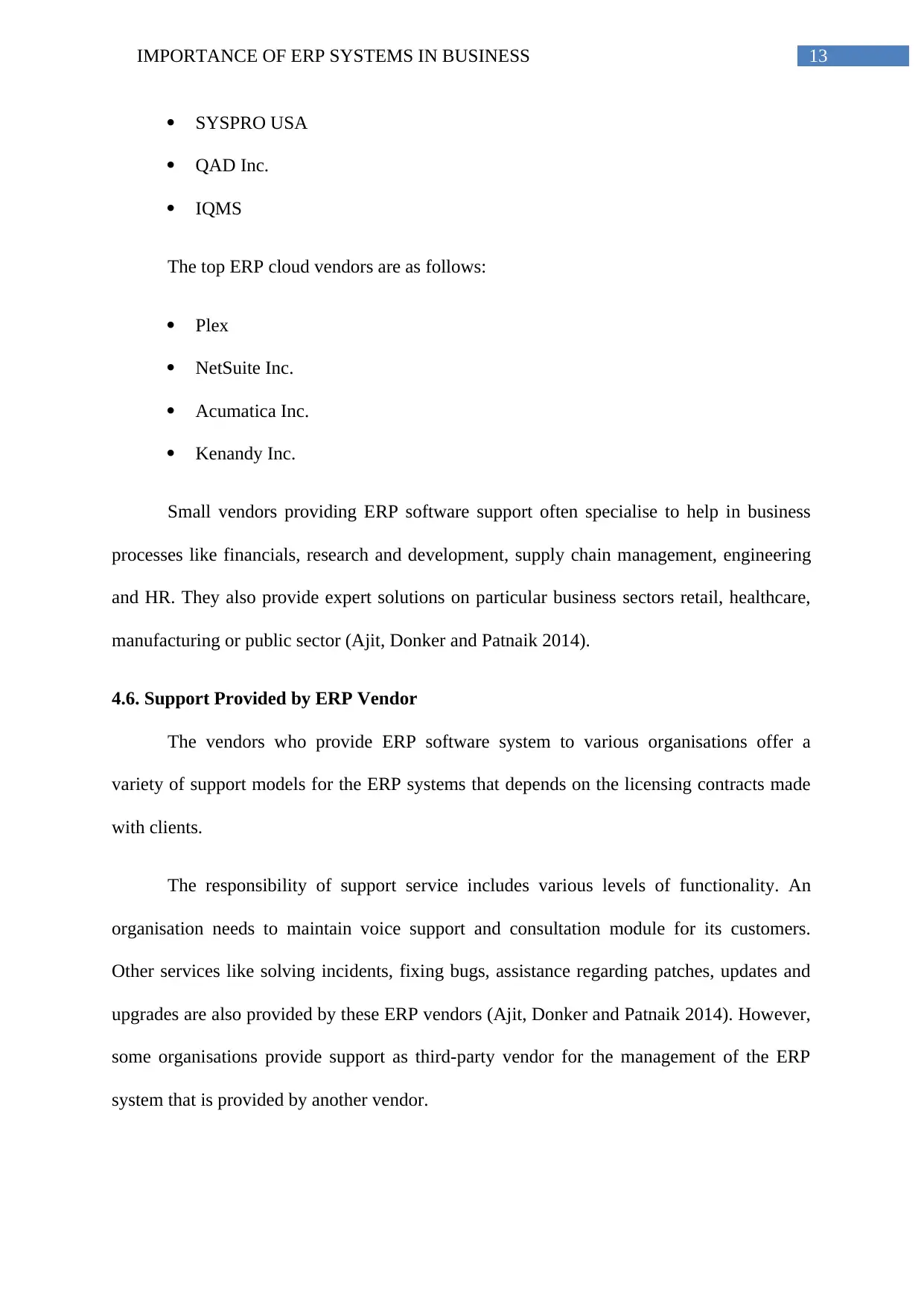
13IMPORTANCE OF ERP SYSTEMS IN BUSINESS
SYSPRO USA
QAD Inc.
IQMS
The top ERP cloud vendors are as follows:
Plex
NetSuite Inc.
Acumatica Inc.
Kenandy Inc.
Small vendors providing ERP software support often specialise to help in business
processes like financials, research and development, supply chain management, engineering
and HR. They also provide expert solutions on particular business sectors retail, healthcare,
manufacturing or public sector (Ajit, Donker and Patnaik 2014).
4.6. Support Provided by ERP Vendor
The vendors who provide ERP software system to various organisations offer a
variety of support models for the ERP systems that depends on the licensing contracts made
with clients.
The responsibility of support service includes various levels of functionality. An
organisation needs to maintain voice support and consultation module for its customers.
Other services like solving incidents, fixing bugs, assistance regarding patches, updates and
upgrades are also provided by these ERP vendors (Ajit, Donker and Patnaik 2014). However,
some organisations provide support as third-party vendor for the management of the ERP
system that is provided by another vendor.
SYSPRO USA
QAD Inc.
IQMS
The top ERP cloud vendors are as follows:
Plex
NetSuite Inc.
Acumatica Inc.
Kenandy Inc.
Small vendors providing ERP software support often specialise to help in business
processes like financials, research and development, supply chain management, engineering
and HR. They also provide expert solutions on particular business sectors retail, healthcare,
manufacturing or public sector (Ajit, Donker and Patnaik 2014).
4.6. Support Provided by ERP Vendor
The vendors who provide ERP software system to various organisations offer a
variety of support models for the ERP systems that depends on the licensing contracts made
with clients.
The responsibility of support service includes various levels of functionality. An
organisation needs to maintain voice support and consultation module for its customers.
Other services like solving incidents, fixing bugs, assistance regarding patches, updates and
upgrades are also provided by these ERP vendors (Ajit, Donker and Patnaik 2014). However,
some organisations provide support as third-party vendor for the management of the ERP
system that is provided by another vendor.
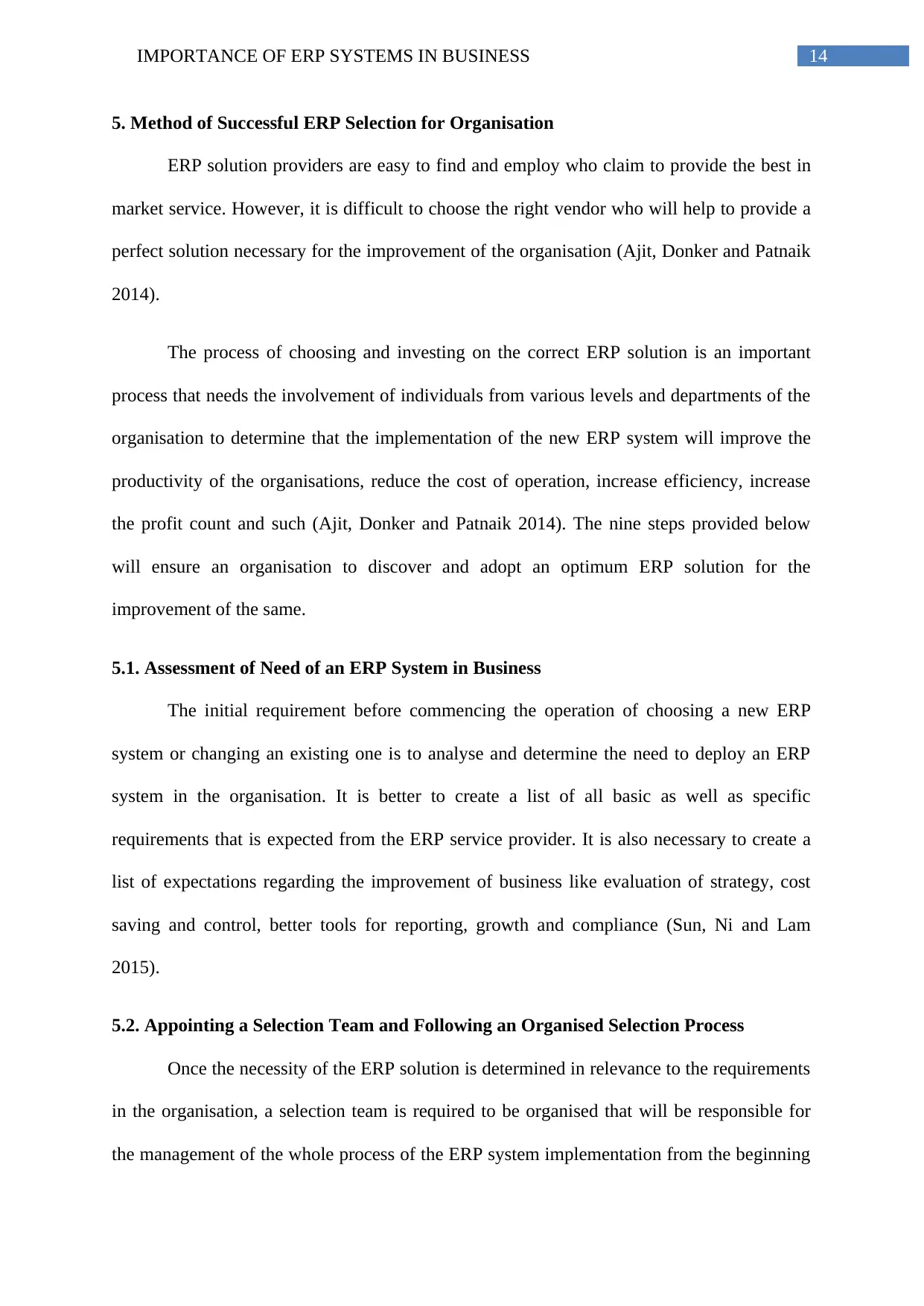
14IMPORTANCE OF ERP SYSTEMS IN BUSINESS
5. Method of Successful ERP Selection for Organisation
ERP solution providers are easy to find and employ who claim to provide the best in
market service. However, it is difficult to choose the right vendor who will help to provide a
perfect solution necessary for the improvement of the organisation (Ajit, Donker and Patnaik
2014).
The process of choosing and investing on the correct ERP solution is an important
process that needs the involvement of individuals from various levels and departments of the
organisation to determine that the implementation of the new ERP system will improve the
productivity of the organisations, reduce the cost of operation, increase efficiency, increase
the profit count and such (Ajit, Donker and Patnaik 2014). The nine steps provided below
will ensure an organisation to discover and adopt an optimum ERP solution for the
improvement of the same.
5.1. Assessment of Need of an ERP System in Business
The initial requirement before commencing the operation of choosing a new ERP
system or changing an existing one is to analyse and determine the need to deploy an ERP
system in the organisation. It is better to create a list of all basic as well as specific
requirements that is expected from the ERP service provider. It is also necessary to create a
list of expectations regarding the improvement of business like evaluation of strategy, cost
saving and control, better tools for reporting, growth and compliance (Sun, Ni and Lam
2015).
5.2. Appointing a Selection Team and Following an Organised Selection Process
Once the necessity of the ERP solution is determined in relevance to the requirements
in the organisation, a selection team is required to be organised that will be responsible for
the management of the whole process of the ERP system implementation from the beginning
5. Method of Successful ERP Selection for Organisation
ERP solution providers are easy to find and employ who claim to provide the best in
market service. However, it is difficult to choose the right vendor who will help to provide a
perfect solution necessary for the improvement of the organisation (Ajit, Donker and Patnaik
2014).
The process of choosing and investing on the correct ERP solution is an important
process that needs the involvement of individuals from various levels and departments of the
organisation to determine that the implementation of the new ERP system will improve the
productivity of the organisations, reduce the cost of operation, increase efficiency, increase
the profit count and such (Ajit, Donker and Patnaik 2014). The nine steps provided below
will ensure an organisation to discover and adopt an optimum ERP solution for the
improvement of the same.
5.1. Assessment of Need of an ERP System in Business
The initial requirement before commencing the operation of choosing a new ERP
system or changing an existing one is to analyse and determine the need to deploy an ERP
system in the organisation. It is better to create a list of all basic as well as specific
requirements that is expected from the ERP service provider. It is also necessary to create a
list of expectations regarding the improvement of business like evaluation of strategy, cost
saving and control, better tools for reporting, growth and compliance (Sun, Ni and Lam
2015).
5.2. Appointing a Selection Team and Following an Organised Selection Process
Once the necessity of the ERP solution is determined in relevance to the requirements
in the organisation, a selection team is required to be organised that will be responsible for
the management of the whole process of the ERP system implementation from the beginning
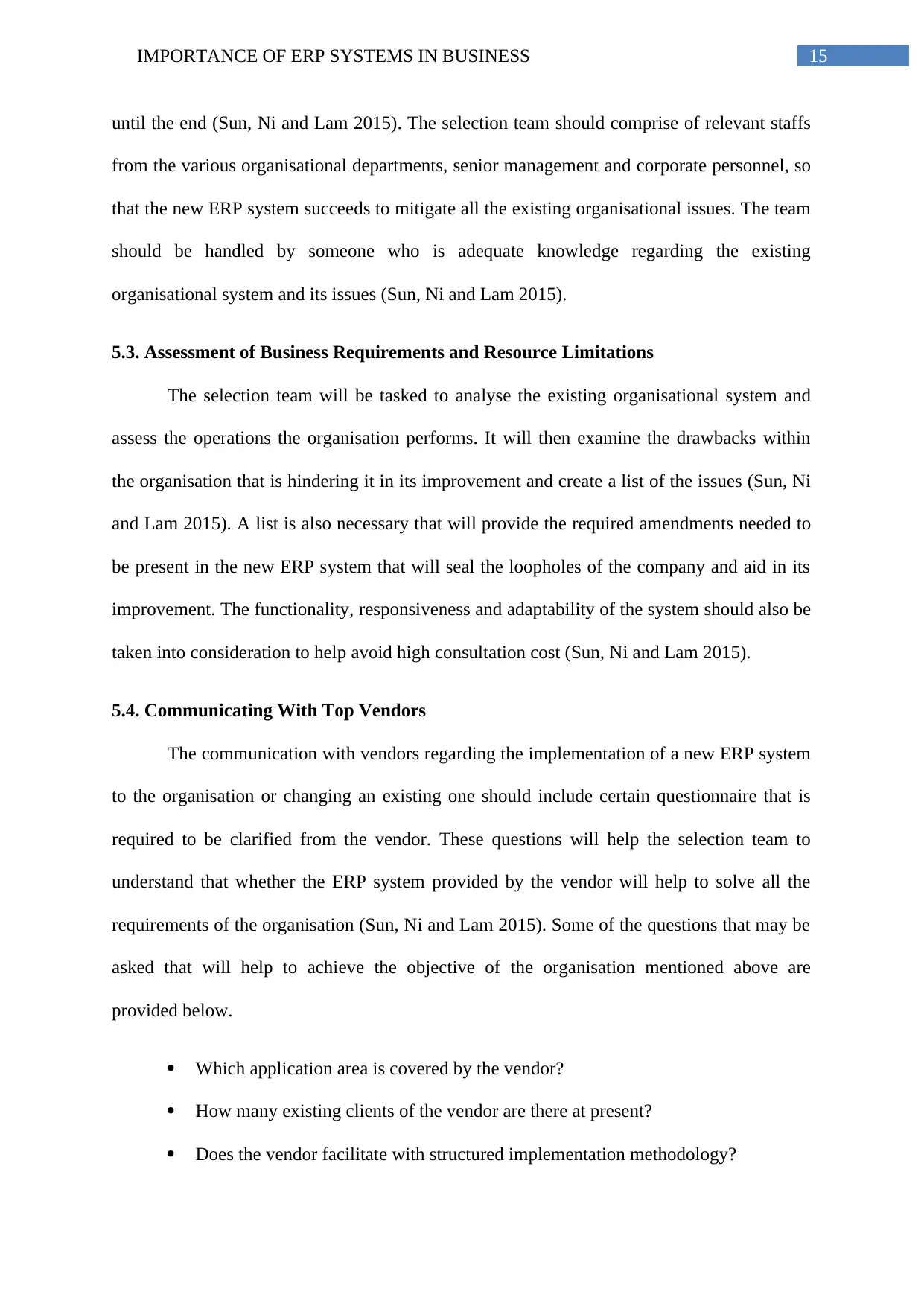
15IMPORTANCE OF ERP SYSTEMS IN BUSINESS
until the end (Sun, Ni and Lam 2015). The selection team should comprise of relevant staffs
from the various organisational departments, senior management and corporate personnel, so
that the new ERP system succeeds to mitigate all the existing organisational issues. The team
should be handled by someone who is adequate knowledge regarding the existing
organisational system and its issues (Sun, Ni and Lam 2015).
5.3. Assessment of Business Requirements and Resource Limitations
The selection team will be tasked to analyse the existing organisational system and
assess the operations the organisation performs. It will then examine the drawbacks within
the organisation that is hindering it in its improvement and create a list of the issues (Sun, Ni
and Lam 2015). A list is also necessary that will provide the required amendments needed to
be present in the new ERP system that will seal the loopholes of the company and aid in its
improvement. The functionality, responsiveness and adaptability of the system should also be
taken into consideration to help avoid high consultation cost (Sun, Ni and Lam 2015).
5.4. Communicating With Top Vendors
The communication with vendors regarding the implementation of a new ERP system
to the organisation or changing an existing one should include certain questionnaire that is
required to be clarified from the vendor. These questions will help the selection team to
understand that whether the ERP system provided by the vendor will help to solve all the
requirements of the organisation (Sun, Ni and Lam 2015). Some of the questions that may be
asked that will help to achieve the objective of the organisation mentioned above are
provided below.
Which application area is covered by the vendor?
How many existing clients of the vendor are there at present?
Does the vendor facilitate with structured implementation methodology?
until the end (Sun, Ni and Lam 2015). The selection team should comprise of relevant staffs
from the various organisational departments, senior management and corporate personnel, so
that the new ERP system succeeds to mitigate all the existing organisational issues. The team
should be handled by someone who is adequate knowledge regarding the existing
organisational system and its issues (Sun, Ni and Lam 2015).
5.3. Assessment of Business Requirements and Resource Limitations
The selection team will be tasked to analyse the existing organisational system and
assess the operations the organisation performs. It will then examine the drawbacks within
the organisation that is hindering it in its improvement and create a list of the issues (Sun, Ni
and Lam 2015). A list is also necessary that will provide the required amendments needed to
be present in the new ERP system that will seal the loopholes of the company and aid in its
improvement. The functionality, responsiveness and adaptability of the system should also be
taken into consideration to help avoid high consultation cost (Sun, Ni and Lam 2015).
5.4. Communicating With Top Vendors
The communication with vendors regarding the implementation of a new ERP system
to the organisation or changing an existing one should include certain questionnaire that is
required to be clarified from the vendor. These questions will help the selection team to
understand that whether the ERP system provided by the vendor will help to solve all the
requirements of the organisation (Sun, Ni and Lam 2015). Some of the questions that may be
asked that will help to achieve the objective of the organisation mentioned above are
provided below.
Which application area is covered by the vendor?
How many existing clients of the vendor are there at present?
Does the vendor facilitate with structured implementation methodology?
Secure Best Marks with AI Grader
Need help grading? Try our AI Grader for instant feedback on your assignments.
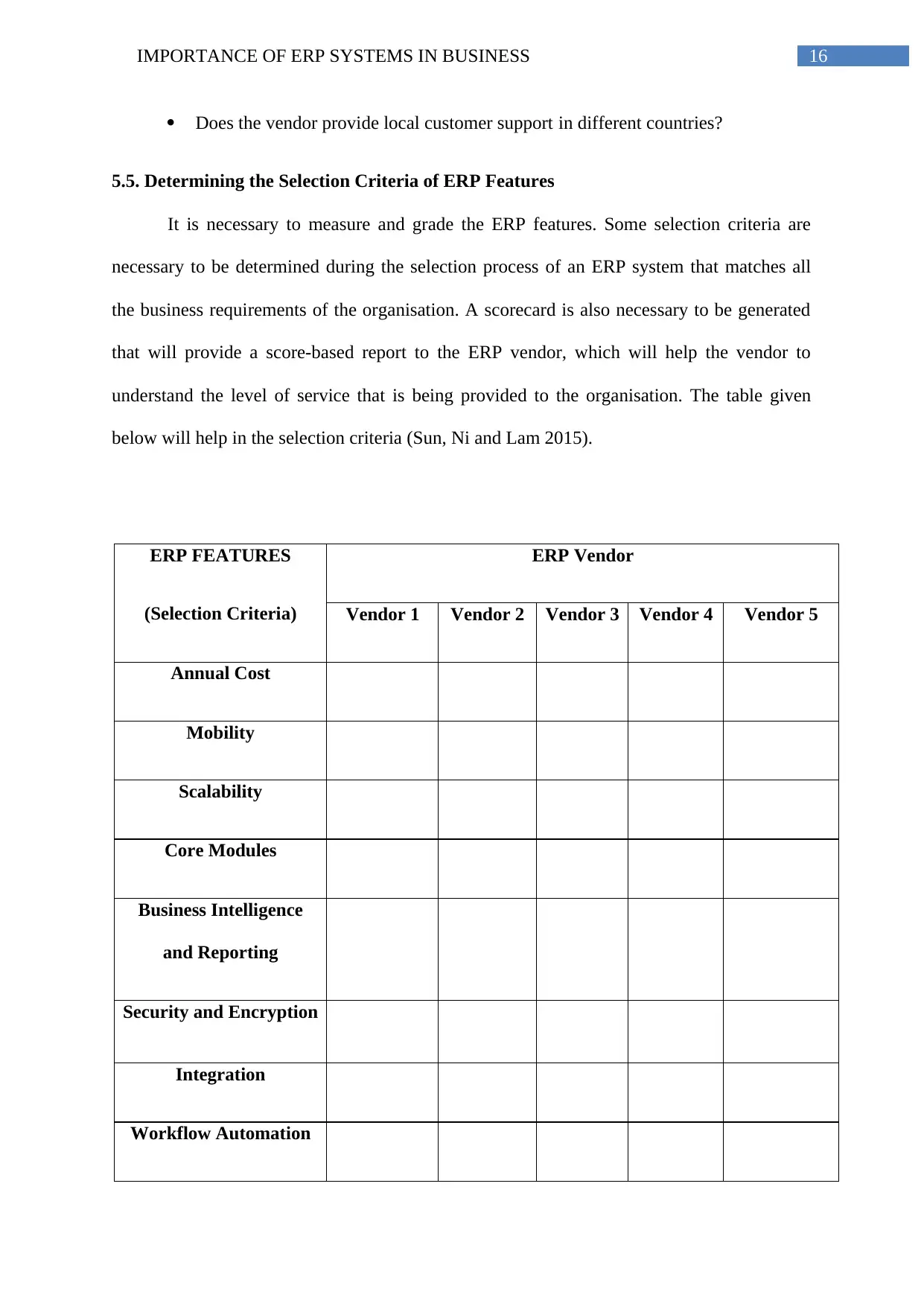
16IMPORTANCE OF ERP SYSTEMS IN BUSINESS
Does the vendor provide local customer support in different countries?
5.5. Determining the Selection Criteria of ERP Features
It is necessary to measure and grade the ERP features. Some selection criteria are
necessary to be determined during the selection process of an ERP system that matches all
the business requirements of the organisation. A scorecard is also necessary to be generated
that will provide a score-based report to the ERP vendor, which will help the vendor to
understand the level of service that is being provided to the organisation. The table given
below will help in the selection criteria (Sun, Ni and Lam 2015).
ERP FEATURES
(Selection Criteria)
ERP Vendor
Vendor 1 Vendor 2 Vendor 3 Vendor 4 Vendor 5
Annual Cost
Mobility
Scalability
Core Modules
Business Intelligence
and Reporting
Security and Encryption
Integration
Workflow Automation
Does the vendor provide local customer support in different countries?
5.5. Determining the Selection Criteria of ERP Features
It is necessary to measure and grade the ERP features. Some selection criteria are
necessary to be determined during the selection process of an ERP system that matches all
the business requirements of the organisation. A scorecard is also necessary to be generated
that will provide a score-based report to the ERP vendor, which will help the vendor to
understand the level of service that is being provided to the organisation. The table given
below will help in the selection criteria (Sun, Ni and Lam 2015).
ERP FEATURES
(Selection Criteria)
ERP Vendor
Vendor 1 Vendor 2 Vendor 3 Vendor 4 Vendor 5
Annual Cost
Mobility
Scalability
Core Modules
Business Intelligence
and Reporting
Security and Encryption
Integration
Workflow Automation

17IMPORTANCE OF ERP SYSTEMS IN BUSINESS
Extensibility
Table 1: Selection Criteria of ERP Features
(Source: Sun, Ni and Lam 2015)
Extensibility
Table 1: Selection Criteria of ERP Features
(Source: Sun, Ni and Lam 2015)
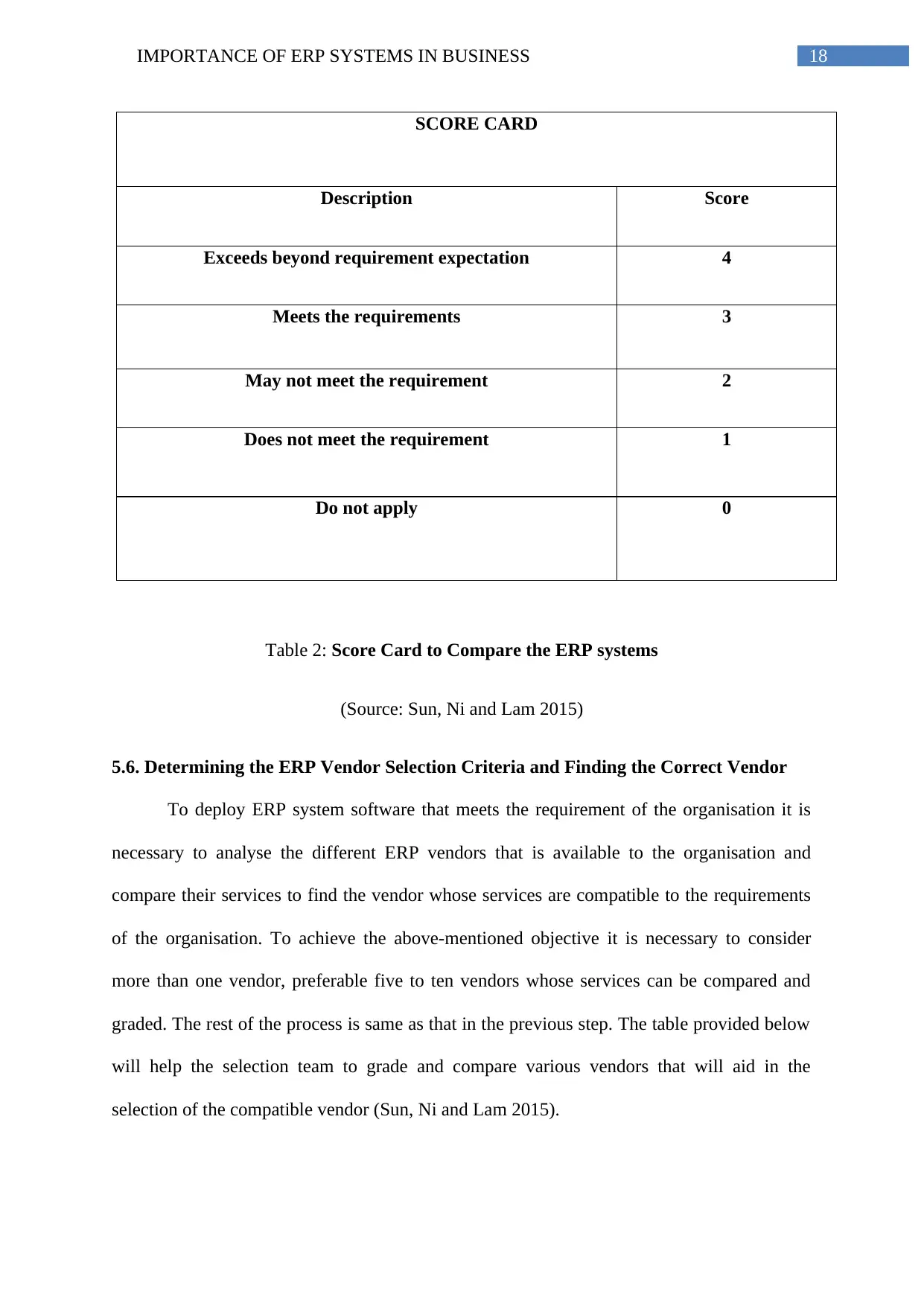
18IMPORTANCE OF ERP SYSTEMS IN BUSINESS
SCORE CARD
Description Score
Exceeds beyond requirement expectation 4
Meets the requirements 3
May not meet the requirement 2
Does not meet the requirement 1
Do not apply 0
Table 2: Score Card to Compare the ERP systems
(Source: Sun, Ni and Lam 2015)
5.6. Determining the ERP Vendor Selection Criteria and Finding the Correct Vendor
To deploy ERP system software that meets the requirement of the organisation it is
necessary to analyse the different ERP vendors that is available to the organisation and
compare their services to find the vendor whose services are compatible to the requirements
of the organisation. To achieve the above-mentioned objective it is necessary to consider
more than one vendor, preferable five to ten vendors whose services can be compared and
graded. The rest of the process is same as that in the previous step. The table provided below
will help the selection team to grade and compare various vendors that will aid in the
selection of the compatible vendor (Sun, Ni and Lam 2015).
SCORE CARD
Description Score
Exceeds beyond requirement expectation 4
Meets the requirements 3
May not meet the requirement 2
Does not meet the requirement 1
Do not apply 0
Table 2: Score Card to Compare the ERP systems
(Source: Sun, Ni and Lam 2015)
5.6. Determining the ERP Vendor Selection Criteria and Finding the Correct Vendor
To deploy ERP system software that meets the requirement of the organisation it is
necessary to analyse the different ERP vendors that is available to the organisation and
compare their services to find the vendor whose services are compatible to the requirements
of the organisation. To achieve the above-mentioned objective it is necessary to consider
more than one vendor, preferable five to ten vendors whose services can be compared and
graded. The rest of the process is same as that in the previous step. The table provided below
will help the selection team to grade and compare various vendors that will aid in the
selection of the compatible vendor (Sun, Ni and Lam 2015).
Paraphrase This Document
Need a fresh take? Get an instant paraphrase of this document with our AI Paraphraser
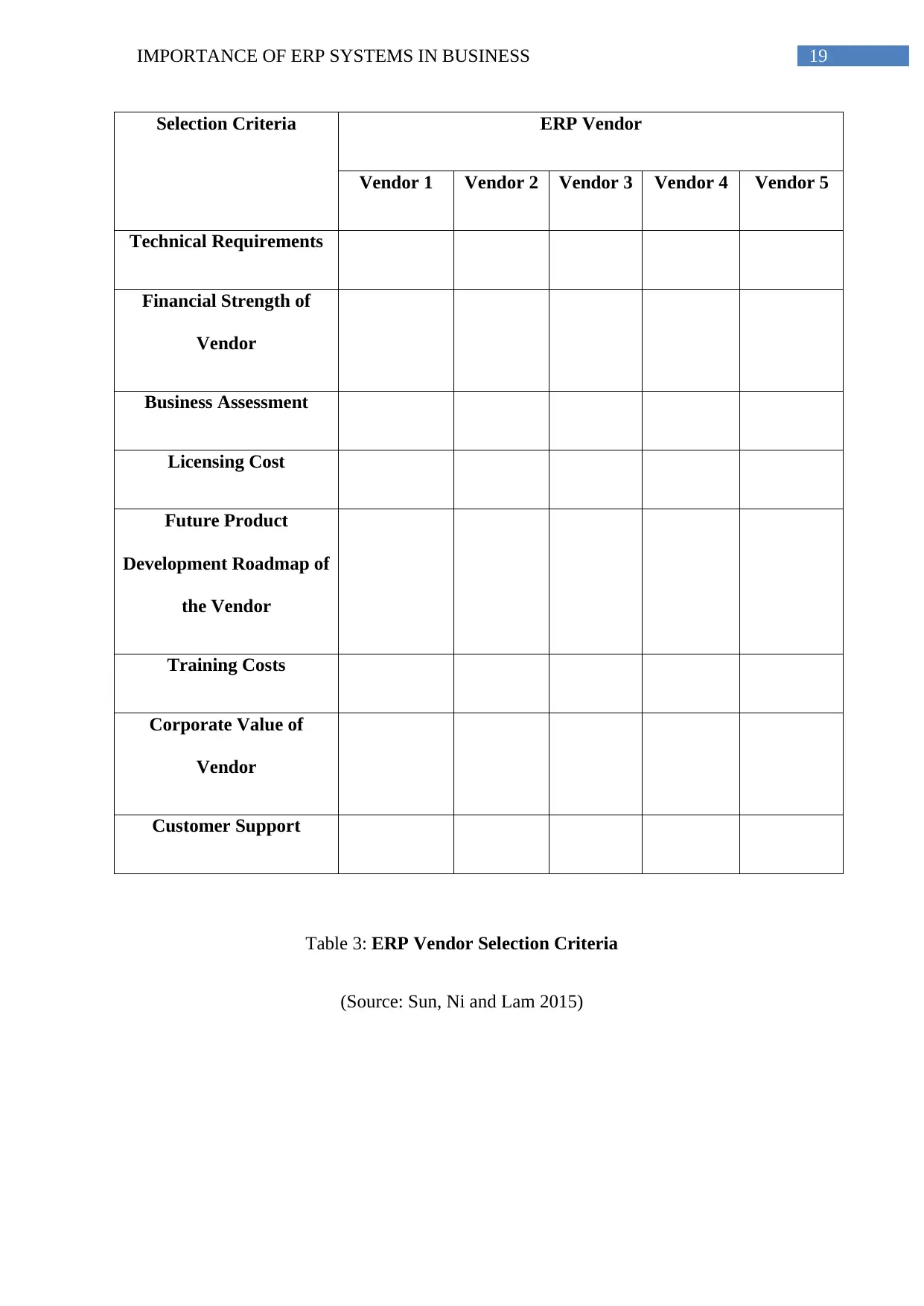
19IMPORTANCE OF ERP SYSTEMS IN BUSINESS
Selection Criteria ERP Vendor
Vendor 1 Vendor 2 Vendor 3 Vendor 4 Vendor 5
Technical Requirements
Financial Strength of
Vendor
Business Assessment
Licensing Cost
Future Product
Development Roadmap of
the Vendor
Training Costs
Corporate Value of
Vendor
Customer Support
Table 3: ERP Vendor Selection Criteria
(Source: Sun, Ni and Lam 2015)
Selection Criteria ERP Vendor
Vendor 1 Vendor 2 Vendor 3 Vendor 4 Vendor 5
Technical Requirements
Financial Strength of
Vendor
Business Assessment
Licensing Cost
Future Product
Development Roadmap of
the Vendor
Training Costs
Corporate Value of
Vendor
Customer Support
Table 3: ERP Vendor Selection Criteria
(Source: Sun, Ni and Lam 2015)
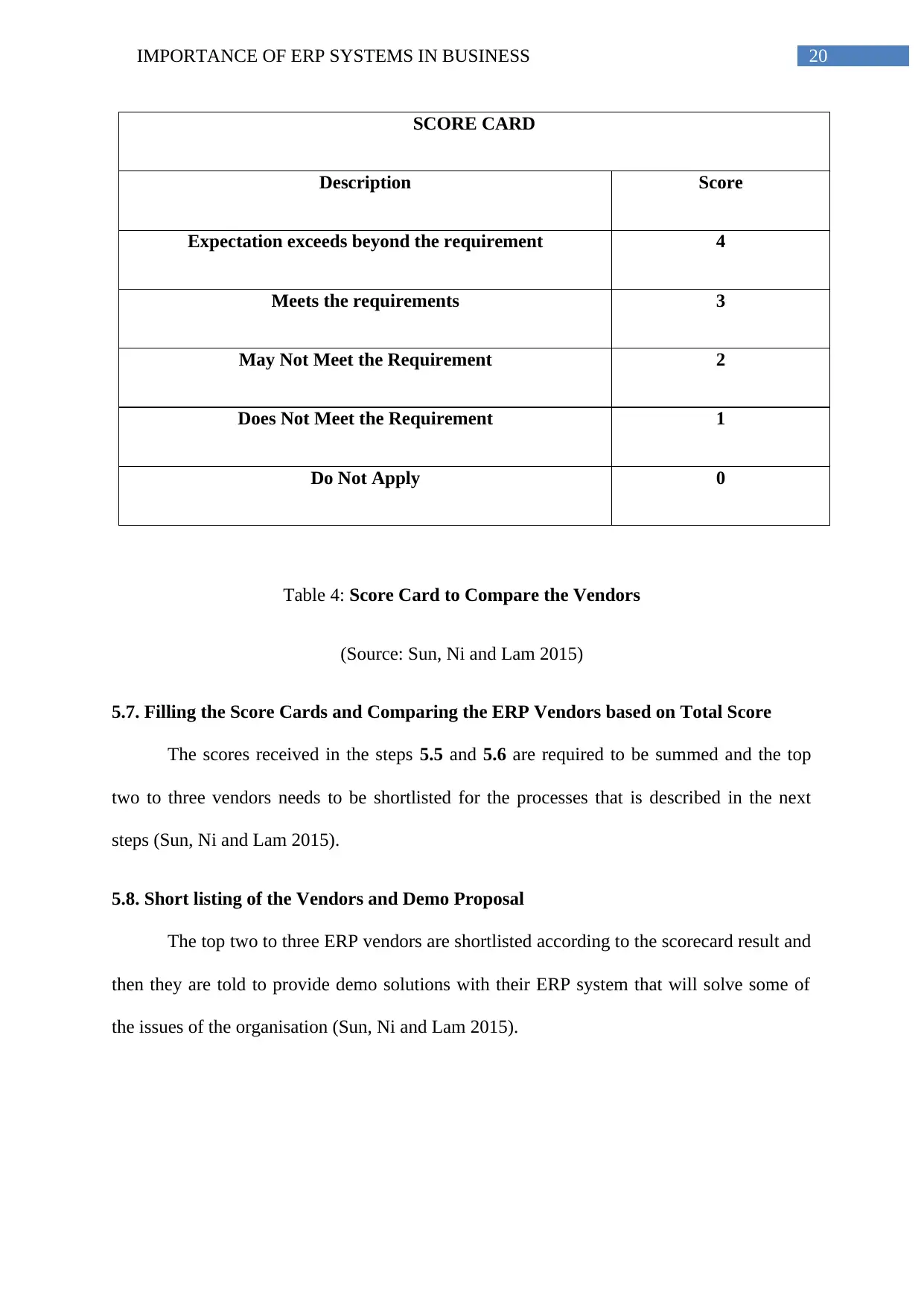
20IMPORTANCE OF ERP SYSTEMS IN BUSINESS
SCORE CARD
Description Score
Expectation exceeds beyond the requirement 4
Meets the requirements 3
May Not Meet the Requirement 2
Does Not Meet the Requirement 1
Do Not Apply 0
Table 4: Score Card to Compare the Vendors
(Source: Sun, Ni and Lam 2015)
5.7. Filling the Score Cards and Comparing the ERP Vendors based on Total Score
The scores received in the steps 5.5 and 5.6 are required to be summed and the top
two to three vendors needs to be shortlisted for the processes that is described in the next
steps (Sun, Ni and Lam 2015).
5.8. Short listing of the Vendors and Demo Proposal
The top two to three ERP vendors are shortlisted according to the scorecard result and
then they are told to provide demo solutions with their ERP system that will solve some of
the issues of the organisation (Sun, Ni and Lam 2015).
SCORE CARD
Description Score
Expectation exceeds beyond the requirement 4
Meets the requirements 3
May Not Meet the Requirement 2
Does Not Meet the Requirement 1
Do Not Apply 0
Table 4: Score Card to Compare the Vendors
(Source: Sun, Ni and Lam 2015)
5.7. Filling the Score Cards and Comparing the ERP Vendors based on Total Score
The scores received in the steps 5.5 and 5.6 are required to be summed and the top
two to three vendors needs to be shortlisted for the processes that is described in the next
steps (Sun, Ni and Lam 2015).
5.8. Short listing of the Vendors and Demo Proposal
The top two to three ERP vendors are shortlisted according to the scorecard result and
then they are told to provide demo solutions with their ERP system that will solve some of
the issues of the organisation (Sun, Ni and Lam 2015).
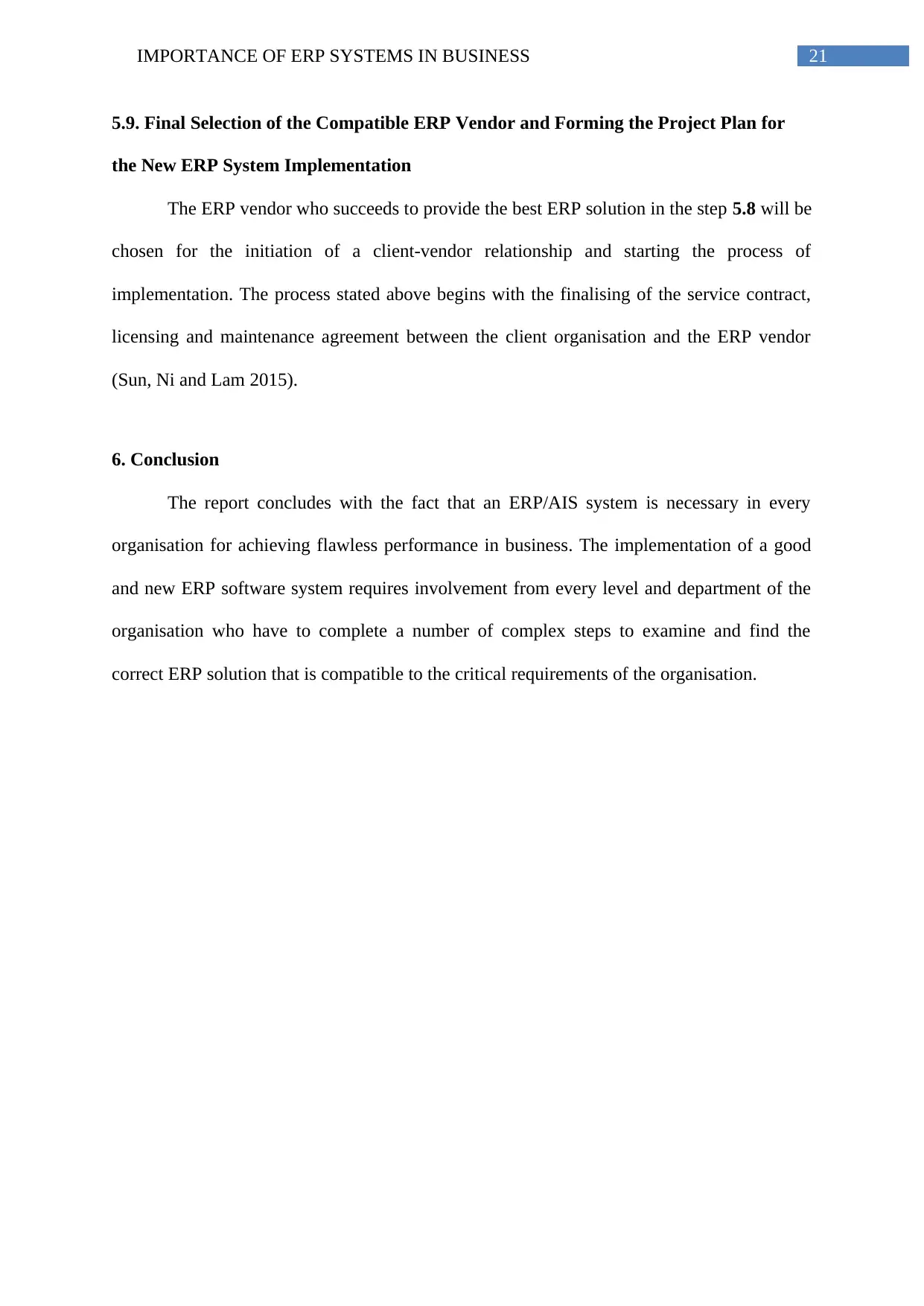
21IMPORTANCE OF ERP SYSTEMS IN BUSINESS
5.9. Final Selection of the Compatible ERP Vendor and Forming the Project Plan for
the New ERP System Implementation
The ERP vendor who succeeds to provide the best ERP solution in the step 5.8 will be
chosen for the initiation of a client-vendor relationship and starting the process of
implementation. The process stated above begins with the finalising of the service contract,
licensing and maintenance agreement between the client organisation and the ERP vendor
(Sun, Ni and Lam 2015).
6. Conclusion
The report concludes with the fact that an ERP/AIS system is necessary in every
organisation for achieving flawless performance in business. The implementation of a good
and new ERP software system requires involvement from every level and department of the
organisation who have to complete a number of complex steps to examine and find the
correct ERP solution that is compatible to the critical requirements of the organisation.
5.9. Final Selection of the Compatible ERP Vendor and Forming the Project Plan for
the New ERP System Implementation
The ERP vendor who succeeds to provide the best ERP solution in the step 5.8 will be
chosen for the initiation of a client-vendor relationship and starting the process of
implementation. The process stated above begins with the finalising of the service contract,
licensing and maintenance agreement between the client organisation and the ERP vendor
(Sun, Ni and Lam 2015).
6. Conclusion
The report concludes with the fact that an ERP/AIS system is necessary in every
organisation for achieving flawless performance in business. The implementation of a good
and new ERP software system requires involvement from every level and department of the
organisation who have to complete a number of complex steps to examine and find the
correct ERP solution that is compatible to the critical requirements of the organisation.
Secure Best Marks with AI Grader
Need help grading? Try our AI Grader for instant feedback on your assignments.
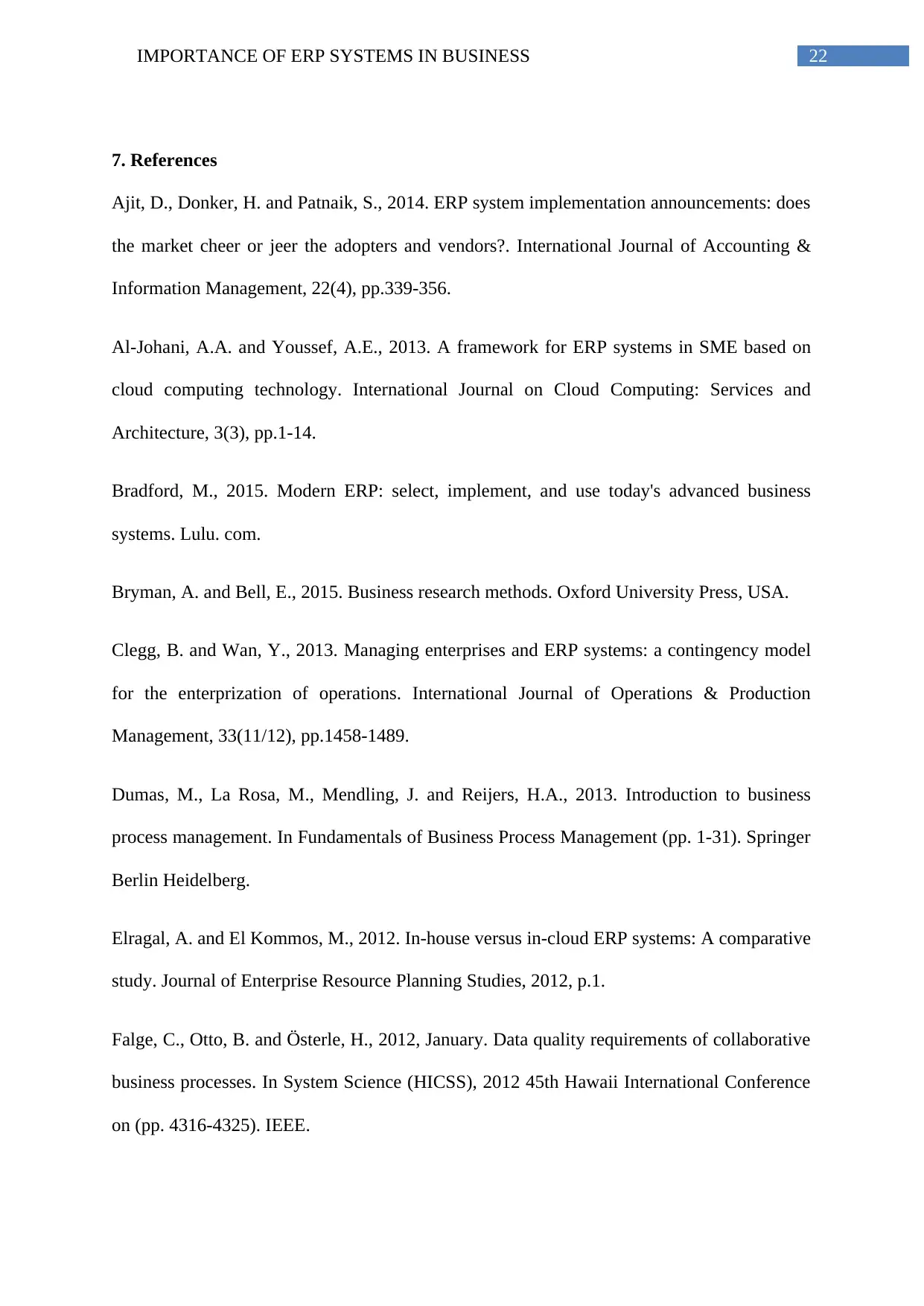
22IMPORTANCE OF ERP SYSTEMS IN BUSINESS
7. References
Ajit, D., Donker, H. and Patnaik, S., 2014. ERP system implementation announcements: does
the market cheer or jeer the adopters and vendors?. International Journal of Accounting &
Information Management, 22(4), pp.339-356.
Al-Johani, A.A. and Youssef, A.E., 2013. A framework for ERP systems in SME based on
cloud computing technology. International Journal on Cloud Computing: Services and
Architecture, 3(3), pp.1-14.
Bradford, M., 2015. Modern ERP: select, implement, and use today's advanced business
systems. Lulu. com.
Bryman, A. and Bell, E., 2015. Business research methods. Oxford University Press, USA.
Clegg, B. and Wan, Y., 2013. Managing enterprises and ERP systems: a contingency model
for the enterprization of operations. International Journal of Operations & Production
Management, 33(11/12), pp.1458-1489.
Dumas, M., La Rosa, M., Mendling, J. and Reijers, H.A., 2013. Introduction to business
process management. In Fundamentals of Business Process Management (pp. 1-31). Springer
Berlin Heidelberg.
Elragal, A. and El Kommos, M., 2012. In-house versus in-cloud ERP systems: A comparative
study. Journal of Enterprise Resource Planning Studies, 2012, p.1.
Falge, C., Otto, B. and Österle, H., 2012, January. Data quality requirements of collaborative
business processes. In System Science (HICSS), 2012 45th Hawaii International Conference
on (pp. 4316-4325). IEEE.
7. References
Ajit, D., Donker, H. and Patnaik, S., 2014. ERP system implementation announcements: does
the market cheer or jeer the adopters and vendors?. International Journal of Accounting &
Information Management, 22(4), pp.339-356.
Al-Johani, A.A. and Youssef, A.E., 2013. A framework for ERP systems in SME based on
cloud computing technology. International Journal on Cloud Computing: Services and
Architecture, 3(3), pp.1-14.
Bradford, M., 2015. Modern ERP: select, implement, and use today's advanced business
systems. Lulu. com.
Bryman, A. and Bell, E., 2015. Business research methods. Oxford University Press, USA.
Clegg, B. and Wan, Y., 2013. Managing enterprises and ERP systems: a contingency model
for the enterprization of operations. International Journal of Operations & Production
Management, 33(11/12), pp.1458-1489.
Dumas, M., La Rosa, M., Mendling, J. and Reijers, H.A., 2013. Introduction to business
process management. In Fundamentals of Business Process Management (pp. 1-31). Springer
Berlin Heidelberg.
Elragal, A. and El Kommos, M., 2012. In-house versus in-cloud ERP systems: A comparative
study. Journal of Enterprise Resource Planning Studies, 2012, p.1.
Falge, C., Otto, B. and Österle, H., 2012, January. Data quality requirements of collaborative
business processes. In System Science (HICSS), 2012 45th Hawaii International Conference
on (pp. 4316-4325). IEEE.
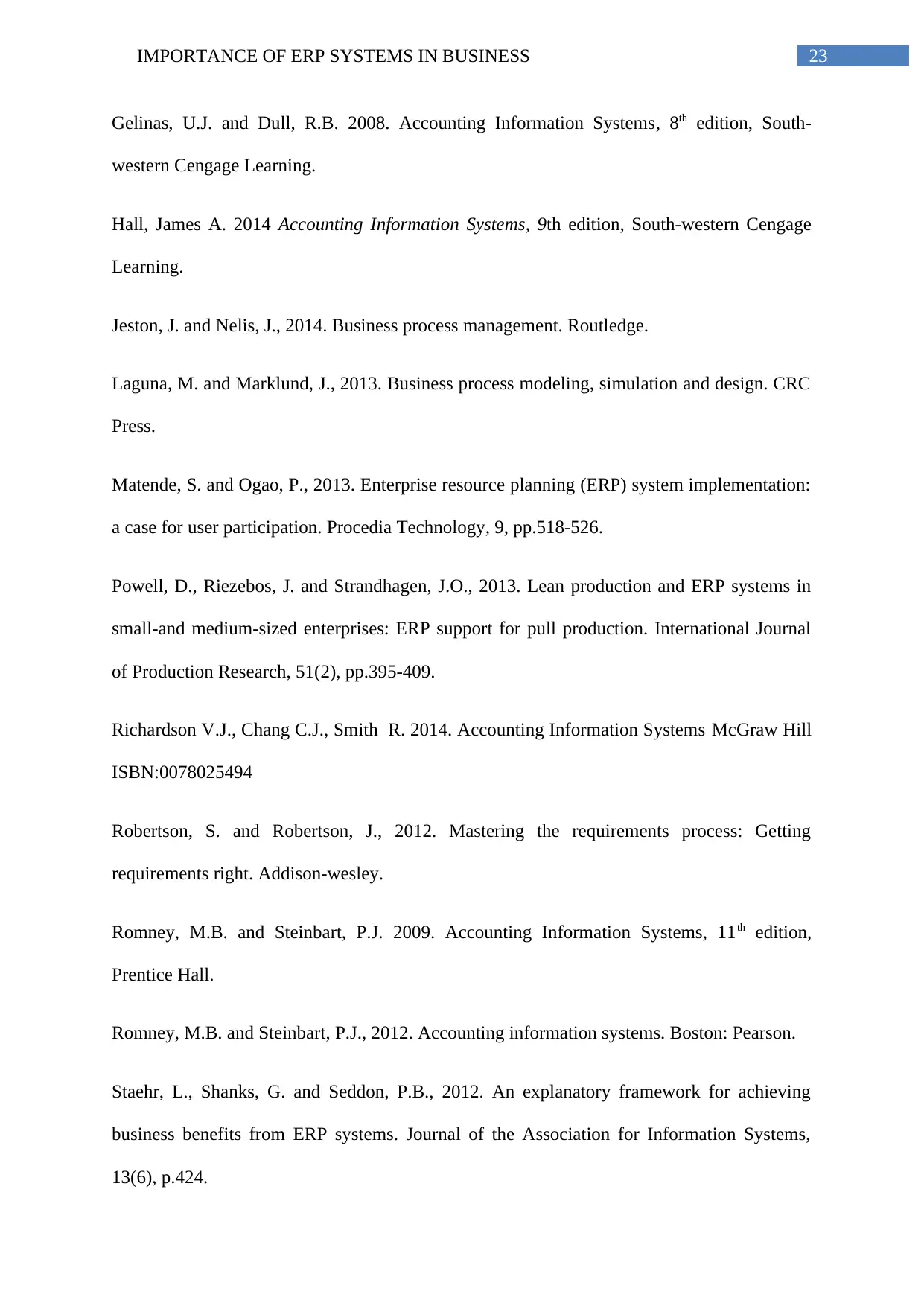
23IMPORTANCE OF ERP SYSTEMS IN BUSINESS
Gelinas, U.J. and Dull, R.B. 2008. Accounting Information Systems, 8th edition, South-
western Cengage Learning.
Hall, James A. 2014 Accounting Information Systems, 9th edition, South-western Cengage
Learning.
Jeston, J. and Nelis, J., 2014. Business process management. Routledge.
Laguna, M. and Marklund, J., 2013. Business process modeling, simulation and design. CRC
Press.
Matende, S. and Ogao, P., 2013. Enterprise resource planning (ERP) system implementation:
a case for user participation. Procedia Technology, 9, pp.518-526.
Powell, D., Riezebos, J. and Strandhagen, J.O., 2013. Lean production and ERP systems in
small-and medium-sized enterprises: ERP support for pull production. International Journal
of Production Research, 51(2), pp.395-409.
Richardson V.J., Chang C.J., Smith R. 2014. Accounting Information Systems McGraw Hill
ISBN:0078025494
Robertson, S. and Robertson, J., 2012. Mastering the requirements process: Getting
requirements right. Addison-wesley.
Romney, M.B. and Steinbart, P.J. 2009. Accounting Information Systems, 11th edition,
Prentice Hall.
Romney, M.B. and Steinbart, P.J., 2012. Accounting information systems. Boston: Pearson.
Staehr, L., Shanks, G. and Seddon, P.B., 2012. An explanatory framework for achieving
business benefits from ERP systems. Journal of the Association for Information Systems,
13(6), p.424.
Gelinas, U.J. and Dull, R.B. 2008. Accounting Information Systems, 8th edition, South-
western Cengage Learning.
Hall, James A. 2014 Accounting Information Systems, 9th edition, South-western Cengage
Learning.
Jeston, J. and Nelis, J., 2014. Business process management. Routledge.
Laguna, M. and Marklund, J., 2013. Business process modeling, simulation and design. CRC
Press.
Matende, S. and Ogao, P., 2013. Enterprise resource planning (ERP) system implementation:
a case for user participation. Procedia Technology, 9, pp.518-526.
Powell, D., Riezebos, J. and Strandhagen, J.O., 2013. Lean production and ERP systems in
small-and medium-sized enterprises: ERP support for pull production. International Journal
of Production Research, 51(2), pp.395-409.
Richardson V.J., Chang C.J., Smith R. 2014. Accounting Information Systems McGraw Hill
ISBN:0078025494
Robertson, S. and Robertson, J., 2012. Mastering the requirements process: Getting
requirements right. Addison-wesley.
Romney, M.B. and Steinbart, P.J. 2009. Accounting Information Systems, 11th edition,
Prentice Hall.
Romney, M.B. and Steinbart, P.J., 2012. Accounting information systems. Boston: Pearson.
Staehr, L., Shanks, G. and Seddon, P.B., 2012. An explanatory framework for achieving
business benefits from ERP systems. Journal of the Association for Information Systems,
13(6), p.424.
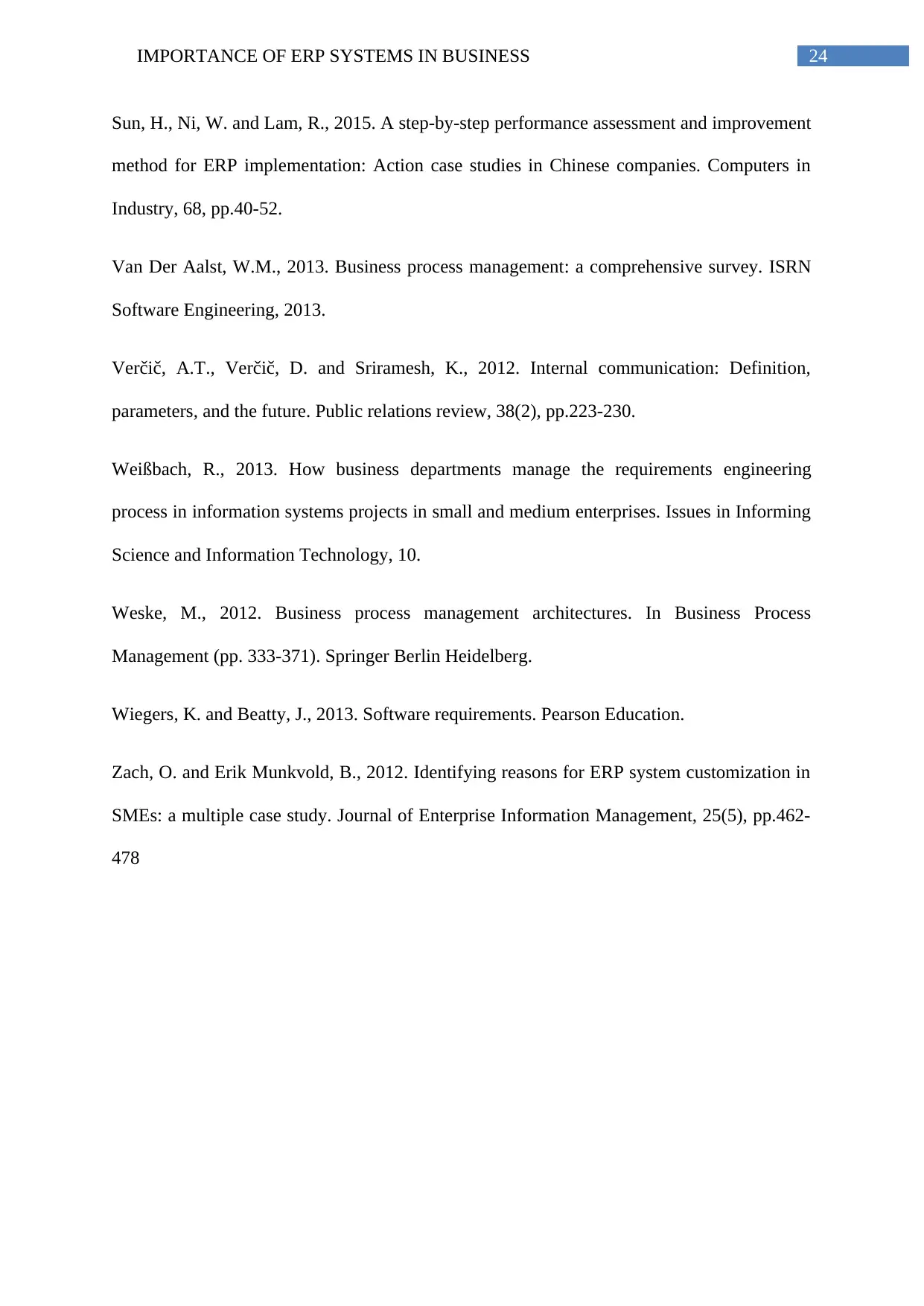
24IMPORTANCE OF ERP SYSTEMS IN BUSINESS
Sun, H., Ni, W. and Lam, R., 2015. A step-by-step performance assessment and improvement
method for ERP implementation: Action case studies in Chinese companies. Computers in
Industry, 68, pp.40-52.
Van Der Aalst, W.M., 2013. Business process management: a comprehensive survey. ISRN
Software Engineering, 2013.
Verčič, A.T., Verčič, D. and Sriramesh, K., 2012. Internal communication: Definition,
parameters, and the future. Public relations review, 38(2), pp.223-230.
Weißbach, R., 2013. How business departments manage the requirements engineering
process in information systems projects in small and medium enterprises. Issues in Informing
Science and Information Technology, 10.
Weske, M., 2012. Business process management architectures. In Business Process
Management (pp. 333-371). Springer Berlin Heidelberg.
Wiegers, K. and Beatty, J., 2013. Software requirements. Pearson Education.
Zach, O. and Erik Munkvold, B., 2012. Identifying reasons for ERP system customization in
SMEs: a multiple case study. Journal of Enterprise Information Management, 25(5), pp.462-
478
Sun, H., Ni, W. and Lam, R., 2015. A step-by-step performance assessment and improvement
method for ERP implementation: Action case studies in Chinese companies. Computers in
Industry, 68, pp.40-52.
Van Der Aalst, W.M., 2013. Business process management: a comprehensive survey. ISRN
Software Engineering, 2013.
Verčič, A.T., Verčič, D. and Sriramesh, K., 2012. Internal communication: Definition,
parameters, and the future. Public relations review, 38(2), pp.223-230.
Weißbach, R., 2013. How business departments manage the requirements engineering
process in information systems projects in small and medium enterprises. Issues in Informing
Science and Information Technology, 10.
Weske, M., 2012. Business process management architectures. In Business Process
Management (pp. 333-371). Springer Berlin Heidelberg.
Wiegers, K. and Beatty, J., 2013. Software requirements. Pearson Education.
Zach, O. and Erik Munkvold, B., 2012. Identifying reasons for ERP system customization in
SMEs: a multiple case study. Journal of Enterprise Information Management, 25(5), pp.462-
478
1 out of 25
Related Documents
Your All-in-One AI-Powered Toolkit for Academic Success.
+13062052269
info@desklib.com
Available 24*7 on WhatsApp / Email
![[object Object]](/_next/static/media/star-bottom.7253800d.svg)
Unlock your academic potential
© 2024 | Zucol Services PVT LTD | All rights reserved.





